Are you seeking one-on-one college counseling and/or essay support? Limited spots are now available. Click here to learn more.

How to Write the Community Essay – Guide with Examples (2023-24)
September 6, 2023
Students applying to college this year will inevitably confront the community essay. In fact, most students will end up responding to several community essay prompts for different schools. For this reason, you should know more than simply how to approach the community essay as a genre. Rather, you will want to learn how to decipher the nuances of each particular prompt, in order to adapt your response appropriately. In this article, we’ll show you how to do just that, through several community essay examples. These examples will also demonstrate how to avoid cliché and make the community essay authentically and convincingly your own.
Emphasis on Community
Do keep in mind that inherent in the word “community” is the idea of multiple people. The personal statement already provides you with a chance to tell the college admissions committee about yourself as an individual. The community essay, however, suggests that you depict yourself among others. You can use this opportunity to your advantage by showing off interpersonal skills, for example. Or, perhaps you wish to relate a moment that forged important relationships. This in turn will indicate what kind of connections you’ll make in the classroom with college peers and professors.
Apart from comprising numerous people, a community can appear in many shapes and sizes. It could be as small as a volleyball team, or as large as a diaspora. It could fill a town soup kitchen, or spread across five boroughs. In fact, due to the internet, certain communities today don’t even require a physical place to congregate. Communities can form around a shared identity, shared place, shared hobby, shared ideology, or shared call to action. They can even arise due to a shared yet unforeseen circumstance.
What is the Community Essay All About?
In a nutshell, the community essay should exhibit three things:
- An aspect of yourself, 2. in the context of a community you belonged to, and 3. how this experience may shape your contribution to the community you’ll join in college.
It may look like a fairly simple equation: 1 + 2 = 3. However, each college will word their community essay prompt differently, so it’s important to look out for additional variables. One college may use the community essay as a way to glimpse your core values. Another may use the essay to understand how you would add to diversity on campus. Some may let you decide in which direction to take it—and there are many ways to go!
To get a better idea of how the prompts differ, let’s take a look at some real community essay prompts from the current admission cycle.
Sample 2023-2024 Community Essay Prompts
1) brown university.
“Students entering Brown often find that making their home on College Hill naturally invites reflection on where they came from. Share how an aspect of your growing up has inspired or challenged you, and what unique contributions this might allow you to make to the Brown community. (200-250 words)”
A close reading of this prompt shows that Brown puts particular emphasis on place. They do this by using the words “home,” “College Hill,” and “where they came from.” Thus, Brown invites writers to think about community through the prism of place. They also emphasize the idea of personal growth or change, through the words “inspired or challenged you.” Therefore, Brown wishes to see how the place you grew up in has affected you. And, they want to know how you in turn will affect their college community.
“NYU was founded on the belief that a student’s identity should not dictate the ability for them to access higher education. That sense of opportunity for all students, of all backgrounds, remains a part of who we are today and a critical part of what makes us a world-class university. Our community embraces diversity, in all its forms, as a cornerstone of the NYU experience.
We would like to better understand how your experiences would help us to shape and grow our diverse community. Please respond in 250 words or less.”
Here, NYU places an emphasis on students’ “identity,” “backgrounds,” and “diversity,” rather than any physical place. (For some students, place may be tied up in those ideas.) Furthermore, while NYU doesn’t ask specifically how identity has changed the essay writer, they do ask about your “experience.” Take this to mean that you can still recount a specific moment, or several moments, that work to portray your particular background. You should also try to link your story with NYU’s values of inclusivity and opportunity.
3) University of Washington
“Our families and communities often define us and our individual worlds. Community might refer to your cultural group, extended family, religious group, neighborhood or school, sports team or club, co-workers, etc. Describe the world you come from and how you, as a product of it, might add to the diversity of the UW. (300 words max) Tip: Keep in mind that the UW strives to create a community of students richly diverse in cultural backgrounds, experiences, values and viewpoints.”
UW ’s community essay prompt may look the most approachable, for they help define the idea of community. You’ll notice that most of their examples (“families,” “cultural group, extended family, religious group, neighborhood”…) place an emphasis on people. This may clue you in on their desire to see the relationships you’ve made. At the same time, UW uses the words “individual” and “richly diverse.” They, like NYU, wish to see how you fit in and stand out, in order to boost campus diversity.
Writing Your First Community Essay
Begin by picking which community essay you’ll write first. (For practical reasons, you’ll probably want to go with whichever one is due earliest.) Spend time doing a close reading of the prompt, as we’ve done above. Underline key words. Try to interpret exactly what the prompt is asking through these keywords.
Next, brainstorm. I recommend doing this on a blank piece of paper with a pencil. Across the top, make a row of headings. These might be the communities you’re a part of, or the components that make up your identity. Then, jot down descriptive words underneath in each column—whatever comes to you. These words may invoke people and experiences you had with them, feelings, moments of growth, lessons learned, values developed, etc. Now, narrow in on the idea that offers the richest material and that corresponds fully with the prompt.
Lastly, write! You’ll definitely want to describe real moments, in vivid detail. This will keep your essay original, and help you avoid cliché. However, you’ll need to summarize the experience and answer the prompt succinctly, so don’t stray too far into storytelling mode.
How To Adapt Your Community Essay
Once your first essay is complete, you’ll need to adapt it to the other colleges involving community essays on your list. Again, you’ll want to turn to the prompt for a close reading, and recognize what makes this prompt different from the last. For example, let’s say you’ve written your essay for UW about belonging to your swim team, and how the sports dynamics shaped you. Adapting that essay to Brown’s prompt could involve more of a focus on place. You may ask yourself, how was my swim team in Alaska different than the swim teams we competed against in other states?
Once you’ve adapted the content, you’ll also want to adapt the wording to mimic the prompt. For example, let’s say your UW essay states, “Thinking back to my years in the pool…” As you adapt this essay to Brown’s prompt, you may notice that Brown uses the word “reflection.” Therefore, you might change this sentence to “Reflecting back on my years in the pool…” While this change is minute, it cleverly signals to the reader that you’ve paid attention to the prompt, and are giving that school your full attention.
What to Avoid When Writing the Community Essay
- Avoid cliché. Some students worry that their idea is cliché, or worse, that their background or identity is cliché. However, what makes an essay cliché is not the content, but the way the content is conveyed. This is where your voice and your descriptions become essential.
- Avoid giving too many examples. Stick to one community, and one or two anecdotes arising from that community that allow you to answer the prompt fully.
- Don’t exaggerate or twist facts. Sometimes students feel they must make themselves sound more “diverse” than they feel they are. Luckily, diversity is not a feeling. Likewise, diversity does not simply refer to one’s heritage. If the prompt is asking about your identity or background, you can show the originality of your experiences through your actions and your thinking.
Community Essay Examples and Analysis
Brown university community essay example.
I used to hate the NYC subway. I’ve taken it since I was six, going up and down Manhattan, to and from school. By high school, it was a daily nightmare. Spending so much time underground, underneath fluorescent lighting, squashed inside a rickety, rocking train car among strangers, some of whom wanted to talk about conspiracy theories, others who had bedbugs or B.O., or who manspread across two seats, or bickered—it wore me out. The challenge of going anywhere seemed absurd. I dreaded the claustrophobia and disgruntlement.
Yet the subway also inspired my understanding of community. I will never forget the morning I saw a man, several seats away, slide out of his seat and hit the floor. The thump shocked everyone to attention. What we noticed: he appeared drunk, possibly homeless. I was digesting this when a second man got up and, through a sort of awkward embrace, heaved the first man back into his seat. The rest of us had stuck to subway social codes: don’t step out of line. Yet this second man’s silent actions spoke loudly. They said, “I care.”
That day I realized I belong to a group of strangers. What holds us together is our transience, our vulnerabilities, and a willingness to assist. This community is not perfect but one in motion, a perpetual work-in-progress. Now I make it my aim to hold others up. I plan to contribute to the Brown community by helping fellow students and strangers in moments of precariousness.
Brown University Community Essay Example Analysis
Here the student finds an original way to write about where they come from. The subway is not their home, yet it remains integral to ideas of belonging. The student shows how a community can be built between strangers, in their responsibility toward each other. The student succeeds at incorporating key words from the prompt (“challenge,” “inspired” “Brown community,” “contribute”) into their community essay.
UW Community Essay Example
I grew up in Hawaii, a world bound by water and rich in diversity. In school we learned that this sacred land was invaded, first by Captain Cook, then by missionaries, whalers, traders, plantation owners, and the U.S. government. My parents became part of this problematic takeover when they moved here in the 90s. The first community we knew was our church congregation. At the beginning of mass, we shook hands with our neighbors. We held hands again when we sang the Lord’s Prayer. I didn’t realize our church wasn’t “normal” until our diocese was informed that we had to stop dancing hula and singing Hawaiian hymns. The order came from the Pope himself.
Eventually, I lost faith in God and organized institutions. I thought the banning of hula—an ancient and pure form of expression—seemed medieval, ignorant, and unfair, given that the Hawaiian religion had already been stamped out. I felt a lack of community and a distrust for any place in which I might find one. As a postcolonial inhabitant, I could never belong to the Hawaiian culture, no matter how much I valued it. Then, I was shocked to learn that Queen Ka’ahumanu herself had eliminated the Kapu system, a strict code of conduct in which women were inferior to men. Next went the Hawaiian religion. Queen Ka’ahumanu burned all the temples before turning to Christianity, hoping this religion would offer better opportunities for her people.
Community Essay (Continued)
I’m not sure what to make of this history. Should I view Queen Ka’ahumanu as a feminist hero, or another failure in her islands’ tragedy? Nothing is black and white about her story, but she did what she thought was beneficial to her people, regardless of tradition. From her story, I’ve learned to accept complexity. I can disagree with institutionalized religion while still believing in my neighbors. I am a product of this place and their presence. At UW, I plan to add to campus diversity through my experience, knowing that diversity comes with contradictions and complications, all of which should be approached with an open and informed mind.
UW Community Essay Example Analysis
This student also manages to weave in words from the prompt (“family,” “community,” “world,” “product of it,” “add to the diversity,” etc.). Moreover, the student picks one of the examples of community mentioned in the prompt, (namely, a religious group,) and deepens their answer by addressing the complexity inherent in the community they’ve been involved in. While the student displays an inner turmoil about their identity and participation, they find a way to show how they’d contribute to an open-minded campus through their values and intellectual rigor.
What’s Next
For more on supplemental essays and essay writing guides, check out the following articles:
- How to Write the Why This Major Essay + Example
- How to Write the Overcoming Challenges Essay + Example
- How to Start a College Essay – 12 Techniques and Tips
- College Essay
Kaylen Baker
With a BA in Literary Studies from Middlebury College, an MFA in Fiction from Columbia University, and a Master’s in Translation from Université Paris 8 Vincennes-Saint-Denis, Kaylen has been working with students on their writing for over five years. Previously, Kaylen taught a fiction course for high school students as part of Columbia Artists/Teachers, and served as an English Language Assistant for the French National Department of Education. Kaylen is an experienced writer/translator whose work has been featured in Los Angeles Review, Hybrid, San Francisco Bay Guardian, France Today, and Honolulu Weekly, among others.
- 2-Year Colleges
- Application Strategies
- Best Colleges by Major
- Best Colleges by State
- Big Picture
- Career & Personality Assessment
- College Search/Knowledge
- College Success
- Costs & Financial Aid
- Data Visualizations
- Dental School Admissions
- Extracurricular Activities
- Graduate School Admissions
- High School Success
- High Schools
- Law School Admissions
- Medical School Admissions
- Navigating the Admissions Process
- Online Learning
- Private High School Spotlight
- Summer Program Spotlight
- Summer Programs
- Teacher Tools
- Test Prep Provider Spotlight
“Innovative and invaluable…use this book as your college lifeline.”
— Lynn O'Shaughnessy
Nationally Recognized College Expert
College Planning in Your Inbox
Join our information-packed monthly newsletter.
Think you can get into a top-10 school? Take our chance-me calculator... if you dare. 🔥
Last updated March 21, 2024
Every piece we write is researched and vetted by a former admissions officer. Read about our mission to pull back the admissions curtain.
Blog > Essay Advice , Supplementals > How to Write a Community Supplemental Essay (with Examples)
How to Write a Community Supplemental Essay (with Examples)
Admissions officer reviewed by Ben Bousquet, M.Ed Former Vanderbilt University
Written by Kylie Kistner, MA Former Willamette University Admissions
Key Takeaway
If you're applying to college, there's a good chance you'll be writing a Community Essay for one (or lots) of your supplementals. In this post, we show you how to write one that stands out.
This post is one in a series of posts about the supplemental essays . You can read our core “how-to” supplemental post here .
When schools admit you, they aren’t just admitting you to be a student. They’re also admitting you to be a community member.
Community supplemental essays help universities understand how you would fit into their school community. At their core, Community prompts allow you to explicitly show an admissions officer why you would be the perfect addition to the school’s community.
Let’s get into what a Community supplemental essay is, what strategies you can use to stand out, and which steps you can take to write the best one possible.
What is a Community supplemental essay?
Community supplemental essay prompts come in a number of forms. Some ask you to talk about a community you already belong to, while others ask you to expand on how you would contribute to the school you’re applying to.
Let’s look at a couple of examples.
1: Rice University
Rice is lauded for creating a collaborative atmosphere that enhances the quality of life for all members of our campus community. The Residential College System and undergraduate life is heavily influenced by the unique life experiences and cultural tradition each student brings. What life perspectives would you contribute to the Rice community? 500 word limit.
2: Swarthmore College
Swarthmore students’ worldviews are often forged by their prior experiences and exposure to ideas and values. Our students are often mentored, supported, and developed by their immediate context—in their neighborhoods, communities of faith, families, and classrooms. Reflect on what elements of your home, school, or community have shaped you or positively impacted you. How have you grown or changed because of the influence of your community?
Community Essay Strategy
Your Community essay strategy will likely depend on the kind of Community essay you’re asked to write. As with all supplemental essays, the goal of any community essay should be to write about the strengths that make you a good fit for the school in question.
How to write about a community to which you belong
Most Community essay prompts give you a lot of flexibility in how you define “community.” That means that the community you write about probably isn’t limited to the more formal communities you’re part of like family or school. Your communities can also include friend groups, athletic teams, clubs and organizations, online communities, and more.
There are two things you should consider before you even begin writing your essay.
What school values is the prompt looking for?
Whether they’re listed implicitly or explicitly, Community essay prompts often include values that you can align your essay response with.
To explain, let’s look at this short supplemental prompt from the University of Notre Dame:
If you were given unlimited resources to help solve one problem in your community, what would it be and how would you accomplish it?
Now, this prompt doesn’t outright say anything about values. But the question itself, even being so short, implies a few values:
a) That you should be active in your community
b) That you should be aware of your community’s problems
c) That you know how to problem-solve
d) That you’re able to collaborate with your community
After dissecting the prompt for these values, you can write a Community essay that showcases how you align with them.
What else are admissions officers learning about you through the community you choose?
In addition to showing what a good community member you are, your Community supplemental essays can also let you talk about other parts of your experience. Doing so can help you find the perfect narrative balance among all your essays.
Let’s use a quick example.
If I’m a student applying to computer science programs, then I might choose to write about the community I’ve found in my robotics team. More specifically, I might write about my role as cheerleader and principle problem-solver of my robotics team. Writing about my robotics team allows me to do two things:
Show that I’m a really supportive person in my community, and
Show that I’m on a robotics team that means a lot to me.
Now, it’s important not to co-opt your Community essay and turn it into a secret Extracurricular essay , but it’s important to be thinking about all the information an admissions officer will learn about you based on the community you choose to focus on.
How to write about what you’ll contribute to your new community
The other segment of Community essays are those that ask you to reflect on how your specific experiences will contribute to your new community.
It’s important that you read each prompt carefully so you know what to focus your essay on.
These kinds of Community prompts let you explicitly drive home why you belong at the school you’re applying to.
Here are two suggestions to get you started.
Draw out the values.
This kind of Community prompt also typically contains some kind of reference to values. The Rice prompt is a perfect example of this:
Rice is lauded for creating a collaborative atmosphere that enhances the quality of life for all members of our campus community . The Residential College System and undergraduate life is heavily influenced by the unique life experiences and cultural tradition each student brings. What life perspectives would you contribute to the Rice community? 500 word limit.
There are several values here:
a) Collaboration
b) Enhancing quality of life
c) For all members of the community
d) Residential system (AKA not just in the classroom)
e) Sharing unique life experiences and cultural traditions with other students
Note that the actual question of the prompt is “What life perspectives would you contribute to the Rice community?” If you skimmed the beginning of the prompt to get to the question, you’d miss all these juicy details about what a Rice student looks like.
But with them in mind, you can choose to write about a life perspective that you hold that aligns with these five values.
Find detailed connections to the school.
Since these kinds of Community prompts ask you what you would contribute to the school community, this is your chance to find the most logical and specific connections you can. Browse the school website and social media to find groups, clubs, activities, communities, or support systems that are related to your personal background and experiences. When appropriate based on the prompt, these kinds of connections can help you show how good a fit you are for the school and community.
How to do Community Essay school research
Looking at school values means doing research on the school’s motto, mission statement, and strategic plans. This information is all carefully curated by a university to reflect the core values, initiatives, and goals of an institution. They can guide your Community essay by giving you more values options to include.
We’ll use the Rice mission statement as an example. It says,
As a leading research university with a distinctive commitment to undergraduate education, Rice University aspires to pathbreaking research , unsurpassed teaching , and contribution to the betterment of our world . It seeks to fulfill this mission by cultivating a diverse community of learning and discovery that produces leaders across the spectrum of human endeavor.
I’ve bolded just a few of the most important values we can draw out.
As we’ll see in the next section, I can use these values to brainstorm my Community essay.
How to write a Community Supplemental Essay
Step 1: Read the prompt closely & identify any relevant values.
When writing any supplemental essay, your first step should always be to closely read the prompt. You can even annotate it. It’s important to do this so you know exactly what is being asked of you.
With Community essays specifically, you can also highlight any values you think the prompt is asking you to elaborate on.
Keeping track of the prompt will make sure that you’re not missing anything an admissions officer will be on the lookout for.
Step 2: Brainstorm communities you’re involved in.
If you’re writing a Community essay that asks you to discuss a community you belong to, then your next step will be brainstorming all of your options.
As you brainstorm, keep a running list. Your list can include all kinds of communities you’re involved in.
Communities:
- Model United Nations
- Youth group
- Instagram book club
- My Discord group
Step 3: Think about the role(s) you play in your selected community.
Narrow down your community list to a couple of options. For each remaining option, identify the roles you played, actions you took, and significance you’ve drawn from being part of that group.
Community: Orchestra
These three columns help you get at the most important details you need to include in your community essay.
Step 4: Identify any relevant connections to the school.
Depending on the question the prompt asks of you, your last step may be to do some school research.
Let’s return to the Rice example.
After researching the Rice mission statement, we know that Rice values community members who want to contribute to the “betterment of our world.”
Ah ha! Now we have something solid to work from.
With this value in mind, I can choose to write about a perspective that shows my investment in creating a better world. Maybe that perspective is a specific kind of fundraising tenacity. Maybe it’s always looking for those small improvements that have a big impact. Maybe it’s some combination of both. Whatever it is, I can write a supplemental essay that reflects the values of the university.
Community Essay Mistakes
While writing Community essays may seem fairly straightforward, there are actually a number of ways they can go awry. Specifically, there are three common mistakes students make that you should be on the lookout for.
They don’t address the specific requests of the prompt.
As with all supplemental essays, your Community essay needs to address what the prompt is asking you to do. In Community essays especially, you’ll need to assess whether you’re being asked to talk about a community you’re already part of or the community you hope to join.
Neglecting to read the prompt also means neglecting any help the prompt gives you in terms of values. Remember that you can get clues as to what the school is looking for by analyzing the prompt’s underlying values.
They’re too vague.
Community essays can also go awry when they’re too vague. Your Community essay should reflect on specific, concrete details about your experience. This is especially the case when a Community prompt asks you to talk about a specific moment, challenge, or sequence of events.
Don’t shy away from details. Instead, use them to tell a compelling story.
They don’t make any connections to the school.
Finally, Community essays that don’t make any connections to the school in question miss out on a valuable opportunity to show school fit. Recall from our supplemental essay guide that you should always write supplemental essays with an eye toward showing how well you fit into a particular community.
Community essays are the perfect chance to do that, so try to find relevant and logical school connections to include.
Community Supplemental Essay Example
Example essay: robotics community.
University of Michigan: Everyone belongs to many different communities and/or groups defined by (among other things) shared geography, religion, ethnicity, income, cuisine, interest, race, ideology, or intellectual heritage. Choose one of the communities to which you belong, and describe that community and your place within it. (Required for all applicants; minimum 100 words/maximum 300 words)
From Blendtec’s “Will it Blend?” videos to ZirconTV’s “How to Use a Stud Finder,” I’m a YouTube how-to fiend. This propensity for fix-it knowledge has not only served me well, but it’s also been a lifesaver for my favorite community: my robotics team(( The writer explicitly states the community they’ll be focusing on.)) . While some students spend their after-school hours playing sports or video games, I spend mine tinkering in my garage with three friends, one of whom is made of metal.
Last year, I Googled more fixes than I can count. Faulty wires, misaligned soldering, and failed code were no match for me. My friends watched in awe as I used Boolean Operators to find exactly the information I sought.(( The writer clearly articulates their place in the community.)) But as I agonized over chassis reviews, other unsearchable problems arose.
First((This entire paragraph fulfills the “describe that community” direction in the prompt.)) , there was the matter of registering for our first robotics competition. None of us familiar with bureaucracy, David stepped up and made some calls. His maturity and social skills helped us immediately land a spot. The next issue was branding. Our robot needed a name and a logo, and Connor took it upon himself to learn graphic design. We all voted on Archie’s name and logo design to find the perfect match. And finally, someone needed to enter the ring. Archie took it from there, winning us first place.
The best part about being in this robotics community is the collaboration and exchange of knowledge.((The writer emphasizes a clear strength: collaboration within their community. It’s clear that the writer values all contributions to the team.)) Although I can figure out how to fix anything, it’s impossible to google social skills, creativity, or courage. For that information, only friends will do. I can only imagine the fixes I’ll bring to the University of Michigan and the skills I’ll learn in return at part of the Manufacturing Robotics community((The writer ends with a forward-looking connection to the school in question.)) .
Want to see even more supplemental essay examples? Check out our college essay examples post .
Liked that? Try this next.

How to Write Supplemental Essays that Will Impress Admissions Officers

How to Write a College Essay (Exercises + Examples)

Extracurricular Magnitude and Impact
"the only actually useful chance calculator i’ve seen—plus a crash course on the application review process.".
Irena Smith, Former Stanford Admissions Officer
We built the best admissions chancer in the world . How is it the best? It draws from our experience in top-10 admissions offices to show you how selective admissions actually works.

Choose Your Test
Sat / act prep online guides and tips, how to write a great community service essay.
College Admissions , Extracurriculars

Are you applying to a college or a scholarship that requires a community service essay? Do you know how to write an essay that will impress readers and clearly show the impact your work had on yourself and others?
Read on to learn step-by-step instructions for writing a great community service essay that will help you stand out and be memorable.
What Is a Community Service Essay? Why Do You Need One?
A community service essay is an essay that describes the volunteer work you did and the impact it had on you and your community. Community service essays can vary widely depending on specific requirements listed in the application, but, in general, they describe the work you did, why you found the work important, and how it benefited people around you.
Community service essays are typically needed for two reasons:
#1: To Apply to College
- Some colleges require students to write community service essays as part of their application or to be eligible for certain scholarships.
- You may also choose to highlight your community service work in your personal statement.
#2: To Apply for Scholarships
- Some scholarships are specifically awarded to students with exceptional community service experiences, and many use community service essays to help choose scholarship recipients.
- Green Mountain College offers one of the most famous of these scholarships. Their "Make a Difference Scholarship" offers full tuition, room, and board to students who have demonstrated a significant, positive impact through their community service
Getting Started With Your Essay
In the following sections, I'll go over each step of how to plan and write your essay. I'll also include sample excerpts for you to look through so you can get a better idea of what readers are looking for when they review your essay.
Step 1: Know the Essay Requirements
Before your start writing a single word, you should be familiar with the essay prompt. Each college or scholarship will have different requirements for their essay, so make sure you read these carefully and understand them.
Specific things to pay attention to include:
- Length requirement
- Application deadline
- The main purpose or focus of the essay
- If the essay should follow a specific structure
Below are three real community service essay prompts. Read through them and notice how much they vary in terms of length, detail, and what information the writer should include.
From the Equitable Excellence Scholarship:
"Describe your outstanding achievement in depth and provide the specific planning, training, goals, and steps taken to make the accomplishment successful. Include details about your role and highlight leadership you provided. Your essay must be a minimum of 350 words but not more than 600 words."
From the Laura W. Bush Traveling Scholarship:
"Essay (up to 500 words, double spaced) explaining your interest in being considered for the award and how your proposed project reflects or is related to both UNESCO's mandate and U.S. interests in promoting peace by sharing advances in education, science, culture, and communications."
From the LULAC National Scholarship Fund:
"Please type or print an essay of 300 words (maximum) on how your academic studies will contribute to your personal & professional goals. In addition, please discuss any community service or extracurricular activities you have been involved in that relate to your goals."

Step 2: Brainstorm Ideas
Even after you understand what the essay should be about, it can still be difficult to begin writing. Answer the following questions to help brainstorm essay ideas. You may be able to incorporate your answers into your essay.
- What community service activity that you've participated in has meant the most to you?
- What is your favorite memory from performing community service?
- Why did you decide to begin community service?
- What made you decide to volunteer where you did?
- How has your community service changed you?
- How has your community service helped others?
- How has your community service affected your plans for the future?
You don't need to answer all the questions, but if you find you have a lot of ideas for one of two of them, those may be things you want to include in your essay.
Writing Your Essay
How you structure your essay will depend on the requirements of the scholarship or school you are applying to. You may give an overview of all the work you did as a volunteer, or highlight a particularly memorable experience. You may focus on your personal growth or how your community benefited.
Regardless of the specific structure requested, follow the guidelines below to make sure your community service essay is memorable and clearly shows the impact of your work.
Samples of mediocre and excellent essays are included below to give you a better idea of how you should draft your own essay.
Step 1: Hook Your Reader In
You want the person reading your essay to be interested, so your first sentence should hook them in and entice them to read more. A good way to do this is to start in the middle of the action. Your first sentence could describe you helping build a house, releasing a rescued animal back to the wild, watching a student you tutored read a book on their own, or something else that quickly gets the reader interested. This will help set your essay apart and make it more memorable.
Compare these two opening sentences:
"I have volunteered at the Wishbone Pet Shelter for three years."
"The moment I saw the starving, mud-splattered puppy brought into the shelter with its tail between its legs, I knew I'd do whatever I could to save it."
The first sentence is a very general, bland statement. The majority of community service essays probably begin a lot like it, but it gives the reader little information and does nothing to draw them in. On the other hand, the second sentence begins immediately with action and helps persuade the reader to keep reading so they can learn what happened to the dog.
Step 2: Discuss the Work You Did
Once you've hooked your reader in with your first sentence, tell them about your community service experiences. State where you work, when you began working, how much time you've spent there, and what your main duties include. This will help the reader quickly put the rest of the essay in context and understand the basics of your community service work.

Not including basic details about your community service could leave your reader confused.
Step 3: Include Specific Details
It's the details of your community service that make your experience unique and memorable, so go into the specifics of what you did.
For example, don't just say you volunteered at a nursing home; talk about reading Mrs. Johnson her favorite book, watching Mr. Scott win at bingo, and seeing the residents play games with their grandchildren at the family day you organized. Try to include specific activities, moments, and people in your essay. Having details like these let the readers really understand what work you did and how it differs from other volunteer experiences.
Compare these two passages:
"For my volunteer work, I tutored children at a local elementary school. I helped them improve their math skills and become more confident students."
"As a volunteer at York Elementary School, I worked one-on-one with second and third graders who struggled with their math skills, particularly addition, subtraction, and fractions. As part of my work, I would create practice problems and quizzes and try to connect math to the students' interests. One of my favorite memories was when Sara, a student I had been working with for several weeks, told me that she enjoyed the math problems I had created about a girl buying and selling horses so much that she asked to help me create math problems for other students."
The first passage only gives basic information about the work done by the volunteer; there is very little detail included, and no evidence is given to support her claims. How did she help students improve their math skills? How did she know they were becoming more confident?
The second passage is much more detailed. It recounts a specific story and explains more fully what kind of work the volunteer did, as well as a specific instance of a student becoming more confident with her math skills. Providing more detail in your essay helps support your claims as well as make your essay more memorable and unique.
Step 4: Show Your Personality
It would be very hard to get a scholarship or place at a school if none of your readers felt like they knew much about you after finishing your essay, so make sure that your essay shows your personality. The way to do this is to state your personal strengths, then provide examples to support your claims. Take some time to think about which parts of your personality you would like your essay to highlight, then write about specific examples to show this.
- If you want to show that you're a motivated leader, describe a time when you organized an event or supervised other volunteers.
- If you want to show your teamwork skills, write about a time you helped a group of people work together better.
- If you want to show that you're a compassionate animal lover, write about taking care of neglected shelter animals and helping each of them find homes.
Step 5: State What You Accomplished
After you have described your community service and given specific examples of your work, you want to begin to wrap your essay up by stating your accomplishments. What was the impact of your community service? Did you build a house for a family to move into? Help students improve their reading skills? Clean up a local park? Make sure the impact of your work is clear; don't be worried about bragging here.
If you can include specific numbers, that will also strengthen your essay. Saying "I delivered meals to 24 home-bound senior citizens" is a stronger example than just saying "I delivered meals to lots of senior citizens."
Also be sure to explain why your work matters. Why is what you did important? Did it provide more parks for kids to play in? Help students get better grades? Give people medical care who would otherwise not have gotten it? This is an important part of your essay, so make sure to go into enough detail that your readers will know exactly what you accomplished and how it helped your community.
"My biggest accomplishment during my community service was helping to organize a family event at the retirement home. The children and grandchildren of many residents attended, and they all enjoyed playing games and watching movies together."
"The community service accomplishment that I'm most proud of is the work I did to help organize the First Annual Family Fun Day at the retirement home. My job was to design and organize fun activities that senior citizens and their younger relatives could enjoy. The event lasted eight hours and included ten different games, two performances, and a movie screening with popcorn. Almost 200 residents and family members attended throughout the day. This event was important because it provided an opportunity for senior citizens to connect with their family members in a way they aren't often able to. It also made the retirement home seem more fun and enjoyable to children, and we have seen an increase in the number of kids coming to visit their grandparents since the event."
The second passage is stronger for a variety of reasons. First, it goes into much more detail about the work the volunteer did. The first passage only states that she helped "organize a family event." That really doesn't tell readers much about her work or what her responsibilities were. The second passage is much clearer; her job was to "design and organize fun activities."
The second passage also explains the event in more depth. A family day can be many things; remember that your readers are likely not familiar with what you're talking about, so details help them get a clearer picture.
Lastly, the second passage makes the importance of the event clear: it helped residents connect with younger family members, and it helped retirement homes seem less intimidating to children, so now some residents see their grand kids more often.
Step 6: Discuss What You Learned
One of the final things to include in your essay should be the impact that your community service had on you. You can discuss skills you learned, such as carpentry, public speaking, animal care, or another skill.
You can also talk about how you changed personally. Are you more patient now? More understanding of others? Do you have a better idea of the type of career you want? Go into depth about this, but be honest. Don't say your community service changed your life if it didn't because trite statements won't impress readers.
In order to support your statements, provide more examples. If you say you're more patient now, how do you know this? Do you get less frustrated while playing with your younger siblings? Are you more willing to help group partners who are struggling with their part of the work? You've probably noticed by now that including specific examples and details is one of the best ways to create a strong and believable essay .
"As a result of my community service, I learned a lot about building houses and became a more mature person."
"As a result of my community service, I gained hands-on experience in construction. I learned how to read blueprints, use a hammer and nails, and begin constructing the foundation of a two-bedroom house. Working on the house could be challenging at times, but it taught me to appreciate the value of hard work and be more willing to pitch in when I see someone needs help. My dad has just started building a shed in our backyard, and I offered to help him with it because I know from my community service how much work it is. I also appreciate my own house more, and I know how lucky I am to have a roof over my head."
The second passage is more impressive and memorable because it describes the skills the writer learned in more detail and recounts a specific story that supports her claim that her community service changed her and made her more helpful.

Step 7: Finish Strong
Just as you started your essay in a way that would grab readers' attention, you want to finish your essay on a strong note as well. A good way to end your essay is to state again the impact your work had on you, your community, or both. Reiterate how you changed as a result of your community service, why you found the work important, or how it helped others.
Compare these two concluding statements:
"In conclusion, I learned a lot from my community service at my local museum, and I hope to keep volunteering and learning more about history."
"To conclude, volunteering at my city's American History Museum has been a great experience. By leading tours and participating in special events, I became better at public speaking and am now more comfortable starting conversations with people. In return, I was able to get more community members interested in history and our local museum. My interest in history has deepened, and I look forward to studying the subject in college and hopefully continuing my volunteer work at my university's own museum."
The second passage takes each point made in the first passage and expands upon it. In a few sentences, the second passage is able to clearly convey what work the volunteer did, how she changed, and how her volunteer work benefited her community.
The author of the second passage also ends her essay discussing her future and how she'd like to continue her community service, which is a good way to wrap things up because it shows your readers that you are committed to community service for the long-term.
What's Next?
Are you applying to a community service scholarship or thinking about it? We have a complete list of all the community service scholarships available to help get your search started!
Do you need a community service letter as well? We have a step-by-step guide that will tell you how to get a great reference letter from your community service supervisor.
Thinking about doing community service abroad? Before you sign up, read our guide on some of the hazards of international volunteer trips and how to know if it's the right choice for you.

Christine graduated from Michigan State University with degrees in Environmental Biology and Geography and received her Master's from Duke University. In high school she scored in the 99th percentile on the SAT and was named a National Merit Finalist. She has taught English and biology in several countries.
Ask a Question Below
Have any questions about this article or other topics? Ask below and we'll reply!
Improve With Our Famous Guides
- For All Students
The 5 Strategies You Must Be Using to Improve 160+ SAT Points
How to Get a Perfect 1600, by a Perfect Scorer
Series: How to Get 800 on Each SAT Section:
Score 800 on SAT Math
Score 800 on SAT Reading
Score 800 on SAT Writing
Series: How to Get to 600 on Each SAT Section:
Score 600 on SAT Math
Score 600 on SAT Reading
Score 600 on SAT Writing
Free Complete Official SAT Practice Tests
What SAT Target Score Should You Be Aiming For?
15 Strategies to Improve Your SAT Essay
The 5 Strategies You Must Be Using to Improve 4+ ACT Points
How to Get a Perfect 36 ACT, by a Perfect Scorer
Series: How to Get 36 on Each ACT Section:
36 on ACT English
36 on ACT Math
36 on ACT Reading
36 on ACT Science
Series: How to Get to 24 on Each ACT Section:
24 on ACT English
24 on ACT Math
24 on ACT Reading
24 on ACT Science
What ACT target score should you be aiming for?
ACT Vocabulary You Must Know
ACT Writing: 15 Tips to Raise Your Essay Score
How to Get Into Harvard and the Ivy League
How to Get a Perfect 4.0 GPA
How to Write an Amazing College Essay
What Exactly Are Colleges Looking For?
Is the ACT easier than the SAT? A Comprehensive Guide
Should you retake your SAT or ACT?
When should you take the SAT or ACT?
Stay Informed
Get the latest articles and test prep tips!
Looking for Graduate School Test Prep?
Check out our top-rated graduate blogs here:
GRE Online Prep Blog
GMAT Online Prep Blog
TOEFL Online Prep Blog
Holly R. "I am absolutely overjoyed and cannot thank you enough for helping me!”

The Community Essay
“Duke University seeks a talented, engaged student body that embodies the wide range of human experience; we believe that the diversity of our students makes our community stronger. If you’d like to share a perspective you bring or experiences you’ve had to help us understand you better—perhaps related to a community you belong to, your sexual orientation or gender identity, or your family or cultural background—we encourage you to do so. Real people are reading your application, and we want to do our best to understand and appreciate the real people applying to Duke.”
As with every essay you ship off to admissions – think about something you want admissions to know that hasn’t been represented. What can you expand upon to show your versatility, passion and ability to connect with the world around you?
About CEA HQ
View all posts by CEA HQ »
Written by CEA HQ
Category: Admissions , College Admissions , Essay Tips , Essay Writing , Supplemental Essays
Tags: admissions essay , admissions help , application , application supplement , applications , brainstorming , college admissions , college admissions essay , college application , college application help , college applications , college essay , common application , supplemental essays

Want free stuff?
We thought so. Sign up for free instructional videos, guides, worksheets and more!

One-On-One Advising
Common App Essay Prompt Guide

Supplemental Essay Prompt Guide
- YouTube Tutorials
- Our Approach & Team
- Undergraduate Testimonials
- Postgraduate Testimonials
- Where Our Students Get In
- CEA Gives Back
- Undergraduate Admissions
- Graduate Admissions
- Private School Admissions
- International Student Admissions
- Common App Essay Guide
- Supplemental Essay Guide
- Coalition App Guide
- The CEA Podcast
- Admissions Stats
- Notification Trackers
- Deadline Databases
- College Essay Examples
- Academy and Worksheets
- Waitlist Guides
- Get Started

Cultural Diversity Essay & Community Essay Examples
If you’ve started to research college application requirements for the schools on your list, you might have come across the “cultural diversity essay.” In this guide, we’ll explore the cultural diversity essay in depth. We will compare the cultural diversity essay to the community essay and discuss how to approach these kinds of supplements. We’ll also provide examples of diversity essays and community essay examples. But first, let’s discuss exactly what a cultural diversity essay is.
The purpose of the cultural diversity essay in college applications is to show the admissions committee what makes you unique. The cultural diversity essay also lets you describe what type of “ diversity ” you would bring to campus.
We’ll also highlight a diversity essay sample for three college applications. These include the Georgetown application essay , Rice application essay , and Williams application essay . We’ll provide examples of diversity essays for each college. Then, for each of these college essays that worked, we will analyze their strengths to help you craft your own essays.
Finally, we’ll give you some tips on how to write a cultural diversity essay that will make your applications shine.
But first, let’s explore the types of college essays you might encounter on your college applications.
Types of College Essays

College application requirements will differ among schools. However, you’ll submit one piece of writing to nearly every school on your list—the personal statement . A strong personal statement can help you stand out in the admissions process.
So, how do you know what to write about? That depends on the type of college essay included in your college application requirements.
There are a few main types of college essays that you might encounter in the college admissions process. Theese include the “Why School ” essay, the “Why Major ” essay, and the extracurricular activity essay. This also includes the type of essay we will focus on in this guide—the cultural diversity essay.
“Why School” essay
The “Why School ” essay is exactly what it sounds like. For this type of college essay, you’ll need to underscore why you want to go to this particular school.
However, don’t make the mistake of just listing off what you like about the school. Additionally, don’t just reiterate information you can find on their admissions website. Instead, you’ll want to make connections between what the school offers and how you are a great fit for that college community.
“Why Major” essay
The idea behind the “Why Major ” essay is similar to that of the “Why School ” essay above. However, instead of writing about the school at large, this essay should highlight why you plan to study your chosen major.
There are plenty of directions you could take with this type of essay. For instance, you might describe how you chose this major, what career you plan to pursue upon graduation, or other details.
Extracurricular Activity essay
The extracurricular activity essay asks you to elaborate on one of the activities that you participated in outside of the classroom.
For this type of college essay, you’ll need to select an extracurricular activity that you pursued while you were in high school. Bonus points if you can tie your extracurricular activity into your future major, career goals, or other extracurricular activities for college. Overall, your extracurricular activity essay should go beyond your activities list. In doing so, it should highlight why your chosen activity matters to you.
Cultural Diversity essay
The cultural diversity essay is your chance to expound upon diversity in all its forms. Before you write your cultural diversity essay, you should ask yourself some key questions. These questions can include: How will you bring diversity to your future college campus? What unique perspective do you bring to the table?
Another sub-category of the cultural diversity essay is the gender diversity essay. As its name suggests, this essay would center around the author’s gender. This essay would highlight how gender shapes the way the writer understands the world around them.
Later, we’ll look at examples of diversity essays and other college essays that worked. But before we do, let’s figure out how to identify a cultural diversity essay in the first place.
How to identify a ‘cultural diversity’ essay

So, you’re wondering how you’ll be able to identify a cultural diversity essay as you review your college application requirements.
Aside from the major giveaway of having the word “diversity” in the prompt, a cultural diversity essay will ask you to describe what makes you different from other applicants. In other words, what aspects of your unique culture(s) have influenced your perspective and shaped you into who you are today?
Diversity can refer to race, ethnicity, first-generation status, gender, or anything in between. You can write about a myriad of things in a cultural diversity essay. For instance, you might discuss your personal background, identity, values, experiences, or how you’ve overcome challenges in your life.
However, don’t feel limited in what you can address in a cultural diversity essay. The words “culture” and “diversity” mean different things to different people. Above all, you’ll want your diversity essays for college to be personal and sincere.
How is a ‘community’ essay different?

A community essay can also be considered a cultural diversity essay. In fact, you can think of the community essay as a subcategory of the cultural diversity essay. However, there is a key difference between a community essay and a cultural diversity essay, which we will illustrate below.
You might have already seen some community essay examples while you were researching college application requirements. But how exactly is a community essay different from a cultural diversity essay?
One way to tell the difference between community essay examples and cultural diversity essay examples is by the prompt. A community essay will highlight, well, community . This means it will focus on how your identity will shape your interactions on campus—not just how it informs your own experiences.
Two common forms to look out for
Community essay examples can take two forms. First, you’ll find community essay examples about your past experiences. These let you show the admissions team how you have positively influenced your own community.
Other community essay examples, however, will focus on the future. These community essay examples will ask you to detail how you will contribute to your future college community. We refer to these as college community essay examples.
In college community essay examples, you’ll see applicants detail how they might interact with their fellow students. These essays may also discuss how students plan to positively contribute to the campus community.
As we mentioned above, the community essay, along with community essay examples and college community essay examples, fit into the larger category of the cultural diversity essay. Although we do not have specific community essay examples or college community essay examples in this guide, we will continue to highlight the subtle differences between the two.
Before we continue the discussion of community essay examples and college community essay examples, let’s start with some examples of cultural diversity essay prompts. For each of the cultural diversity essay prompts, we’ll name the institutions that include these diversity essays for college as part of their college application requirements.
What are some examples of ‘cultural diversity’ essays?
Now, you have a better understanding of the similarities and differences between the cultural diversity essay and the community essay. So, next, let’s look at some examples of cultural diversity essay prompts.
The prompts below are from the Georgetown application, Rice application, and Williams application, respectively. As we discuss the similarities and differences between prompts, remember the framework we provided above for what constitutes a cultural diversity essay and a community essay.
Later in this guide, we’ll provide real examples of diversity essays, including Georgetown essay examples, Rice University essay examples, and Williams supplemental essays examples. These are all considered college essays that worked—meaning that the author was accepted into that particular institution.
Georgetown Supplementals Essays
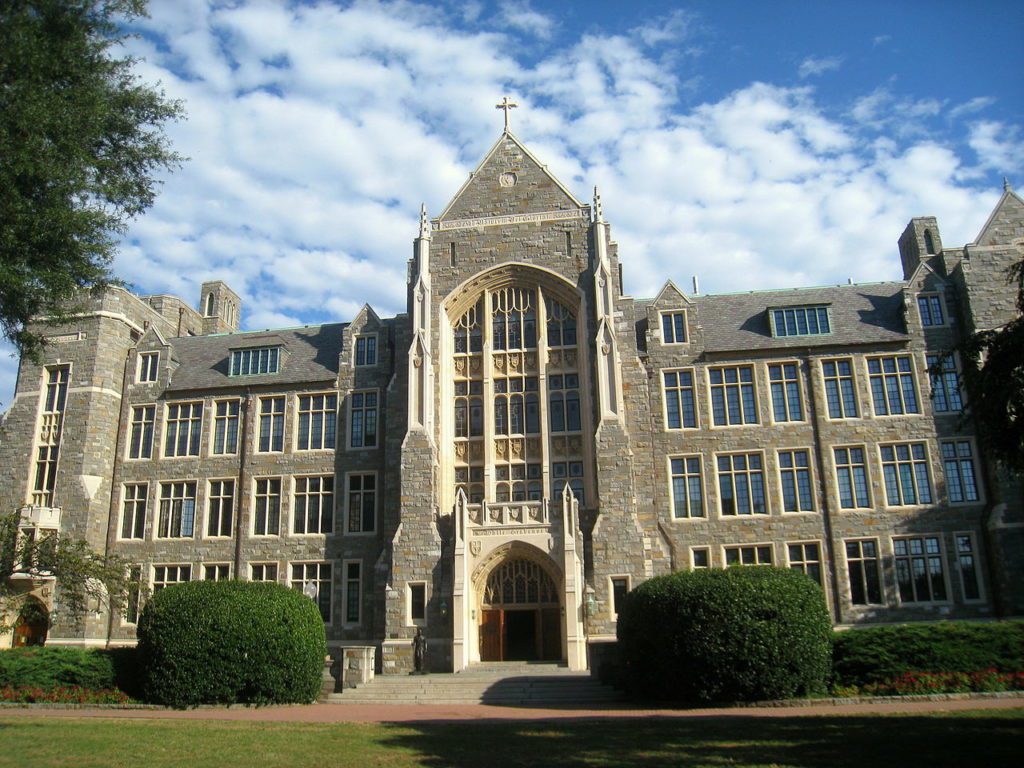
Later, we’ll look at Georgetown supplemental essay examples. Diversity essays for Georgetown are a product of this prompt:
As Georgetown is a diverse community, the Admissions Committee would like to know more about you in your own words. Please submit a brief essay, either personal or creative, which you feel best describes you.
You might have noticed two keywords in this prompt right away: “diverse” and “community.” These buzzwords indicate that this prompt is a cultural diversity essay. You could even argue that responses to this prompt would result in college community essay examples. After all, the prompt refers to the Georgetown community.
For this prompt, you’ll want to produce a diversity essay sample that highlights who you are. In order to do that successfully, you’ll need to self-reflect before putting pen to paper. What aspects of your background, personality, or values best describe who you are? How might your presence at Georgetown influence or contribute to their diverse community?
Additionally, this cultural diversity essay can be personal or creative. So, you have more flexibility with the Georgetown supplemental essays than with other similar diversity essay prompts. Depending on the direction you go, your response to this prompt could be considered a cultural diversity essay, gender diversity essay, or a college community essay.
Rice University Essays
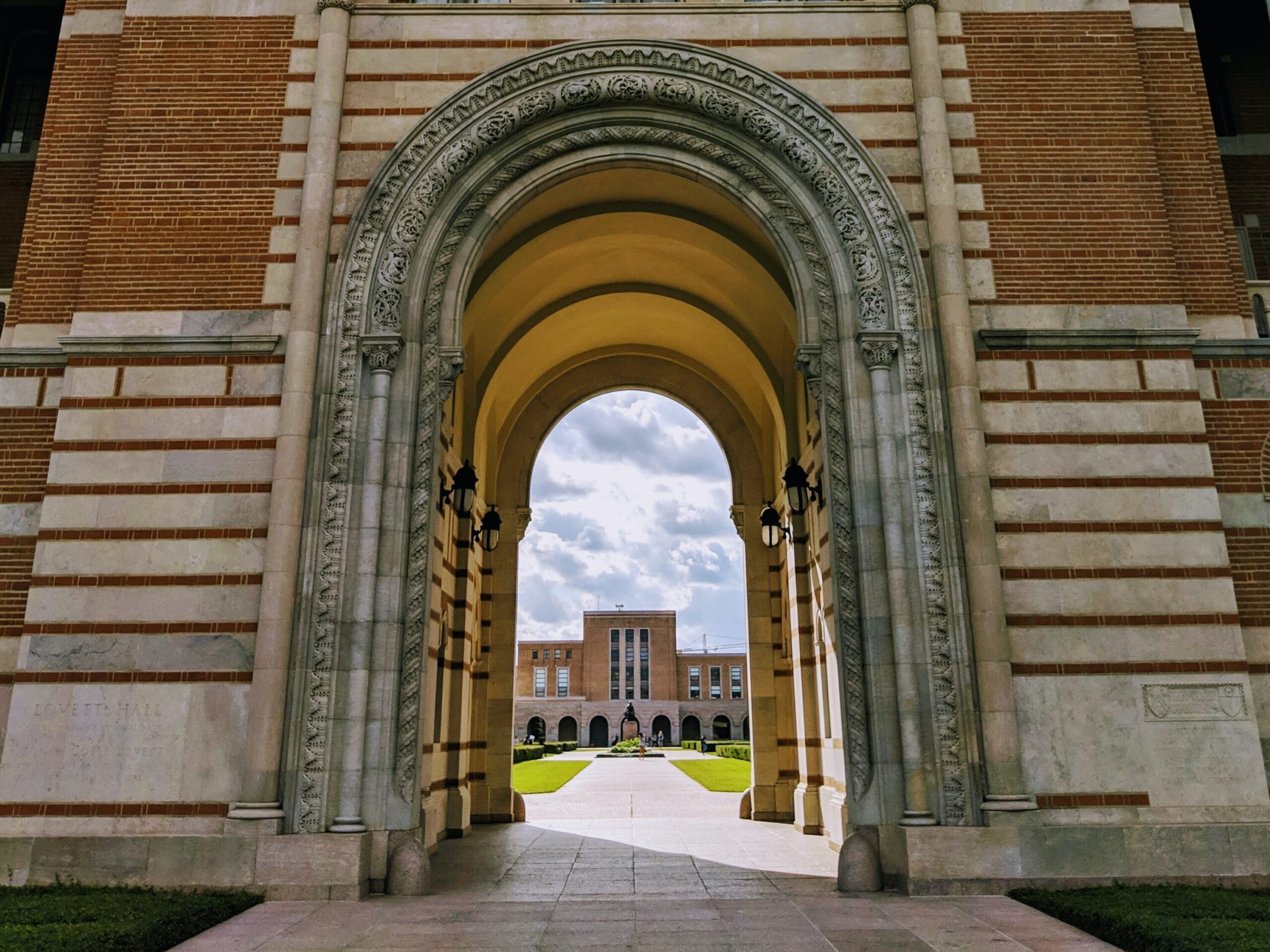
The current Rice acceptance rate is just 9% , making it a highly selective school. Because the Rice acceptance rate is so low, your personal statement and supplemental essays can make a huge difference.
The Rice University essay examples we’ll provide below are based on this prompt:
The quality of Rice’s academic life and the Residential College System are heavily influenced by the unique life experiences and cultural traditions each student brings. What personal perspective would you contribute to life at Rice?
Breaking down the prompt.
Like the prompt above, this cultural diversity essay asks about your “life experiences,” “cultural traditions,” and personal “perspectives.” These phrases indicate a cultural diversity essay. Keep in mind this may not be the exact prompt you’ll have to answer in your own Rice application. However, future Rice prompts will likely follow a similar framework as this diversity essay sample.
Although this prompt is not as flexible as the Georgetown prompt, it does let you discuss aspects of Rice’s academic life and Residential College System that appeal to you. You can also highlight how your experiences have influenced your personal perspective.
The prompt also asks about how you would contribute to life at Rice. So, your response could also fall in line with college community essay examples. Remember, college community essay examples are another sub-category of community essay examples. Successful college community essay examples will illustrate the ways in which students would contribute to their future campus community.

Williams Supplemental Essays
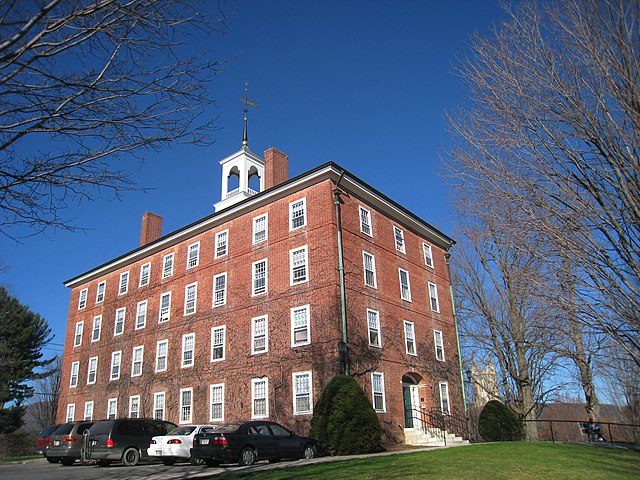
Like the Rice acceptance rate, the Williams acceptance rate is also 9% . Because the Williams acceptance rate is so low, you’ll want to pay close attention to the Williams supplemental essays examples as you begin the writing process.
The Williams supplemental essays examples below are based on this prompt:
Every first-year student at Williams lives in an Entry – a thoughtfully constructed microcosm of the student community that’s a defining part of the Williams experience. From the moment they arrive, students find themselves in what’s likely the most diverse collection of backgrounds, perspectives, and interests they’ve ever encountered. What might differentiate you from the 19 other first-year students in an Entry? What perspective would you add to the conversation with your peer(s)?
Reflecting on the prompt.
Immediately, words like “diverse,” “backgrounds,” “perspectives,” “interests,” and “differentiate” should stand out to you. These keywords highlight the fact that this is a cultural diversity essay. Similar to the Rice essay, this may not be the exact prompt you’ll face on your Williams application. However, we can still learn from it.
Like the Georgetown essay, this prompt requires you to put in some self-reflection before you start writing. What aspects of your background differentiate you from other people? How would these differences impact your interactions with peers?
This prompt also touches on the “student community” and how you would “add to the conversation with your peer(s).” By extension, any strong responses to this prompt could also be considered as college community essay examples.
Community Essays
All of the prompts above mention campus community. So, you could argue that they are also examples of community essays.
Like we mentioned above, you can think of community essays as a subcategory of the cultural diversity essay. If the prompt alludes to the campus community, or if your response is centered on how you would interact within that community, your essay likely falls into the world of college community essay examples.
Regardless of what you would classify the essay as, all successful essays will be thoughtful, personal, and rich with details. We’ll show you examples of this in our “college essays that worked” section below.
Which schools require a cultural diversity or community essay?
Besides Georgetown, Rice, and Williams, many other college applications require a cultural diversity essay or community essay. In fact, from the Ivy League to HBCUs and state schools, the cultural diversity essay is a staple across college applications.
Although we will not provide a diversity essay sample for each of the colleges below, it is helpful to read the prompts. This will build your familiarity with other college applications that require a cultural diversity essay or community essay. Some schools that require a cultural diversity essay or community essay include New York University , Duke University , Harvard University , Johns Hopkins University , and University of Michigan .
New York University
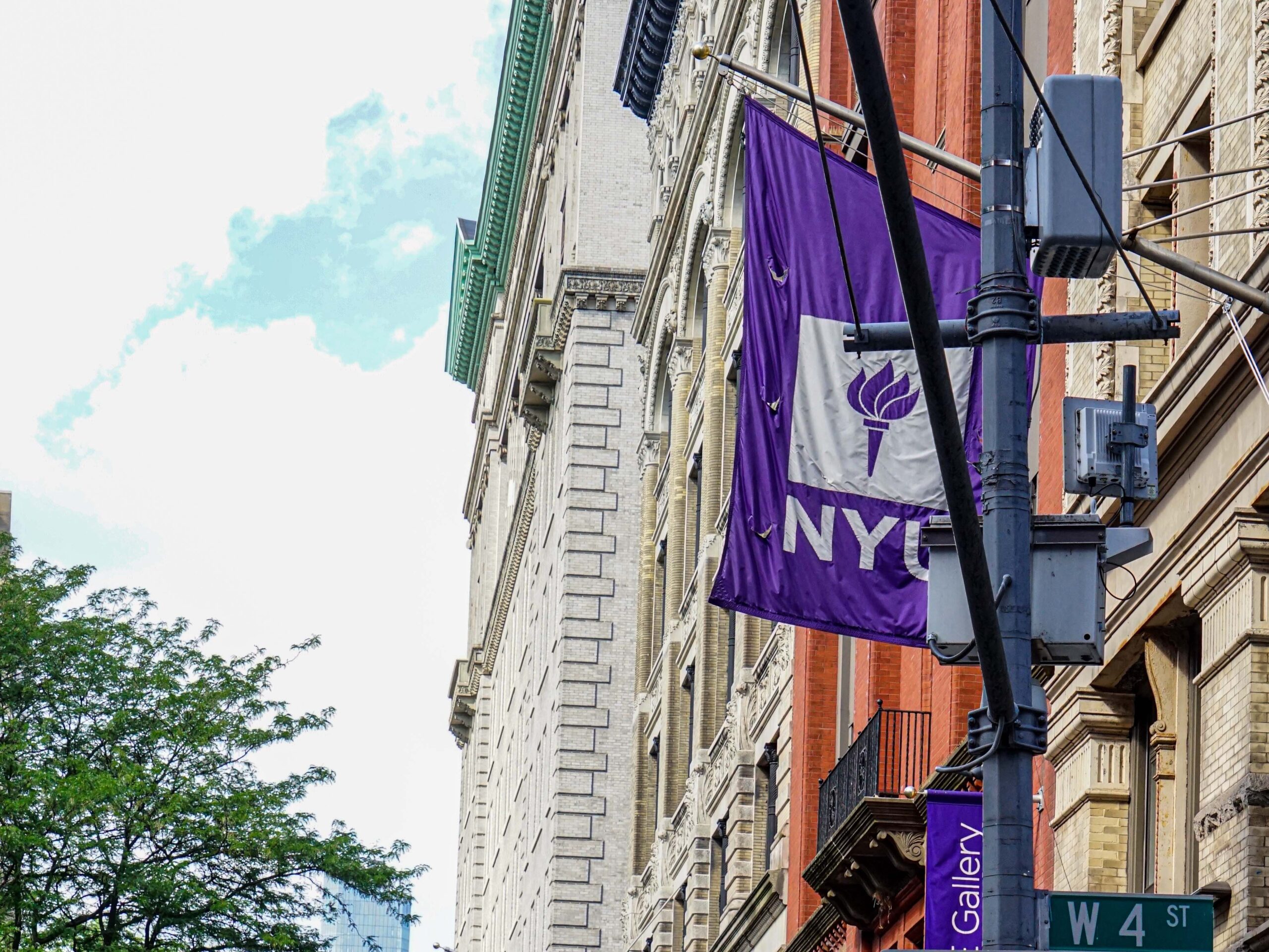
NYU listed a cultural diversity essay as part of its 2022-2023 college application requirements. Here is the prompt:
NYU was founded on the belief that a student’s identity should not dictate the ability for them to access higher education. That sense of opportunity for all students, of all backgrounds, remains a part of who we are today and a critical part of what makes us a world class university. Our community embraces diversity, in all its forms, as a cornerstone of the NYU experience. We would like to better understand how your experiences would help us to shape and grow our diverse community.
Duke university.
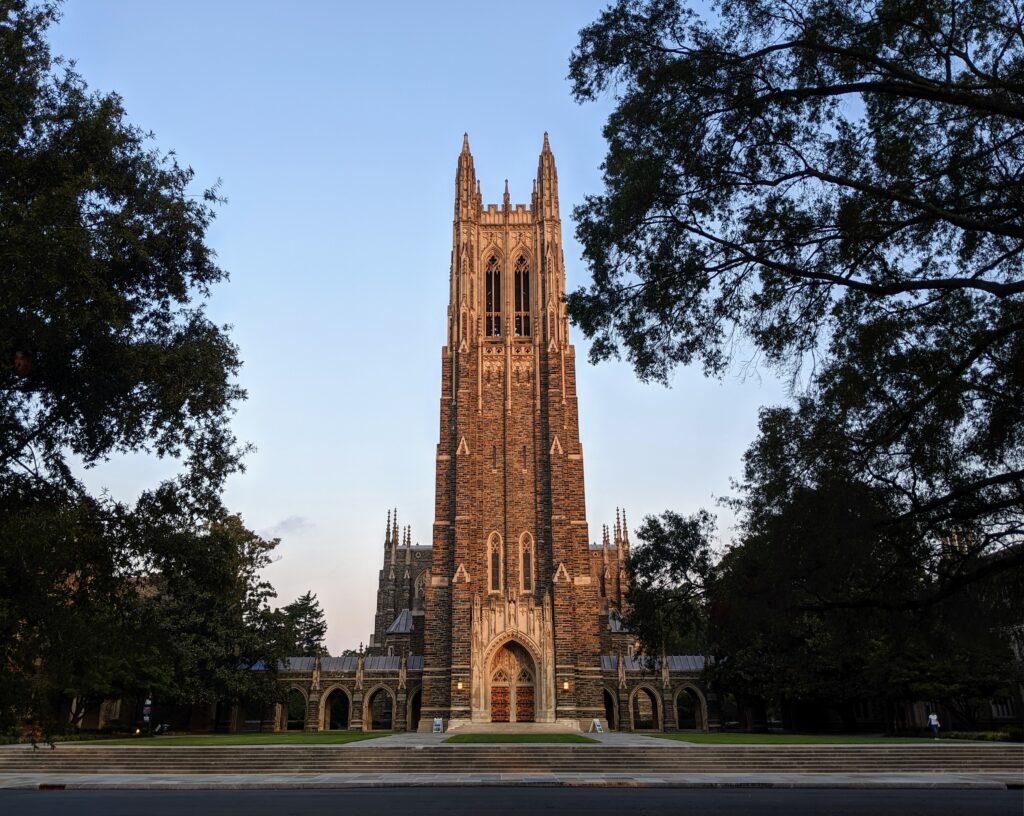
Duke is well-known for its community essay:
What is your sense of Duke as a university and a community, and why do you consider it a good match for you? If there’s something in particular about our offerings that attracts you, feel free to share that as well.
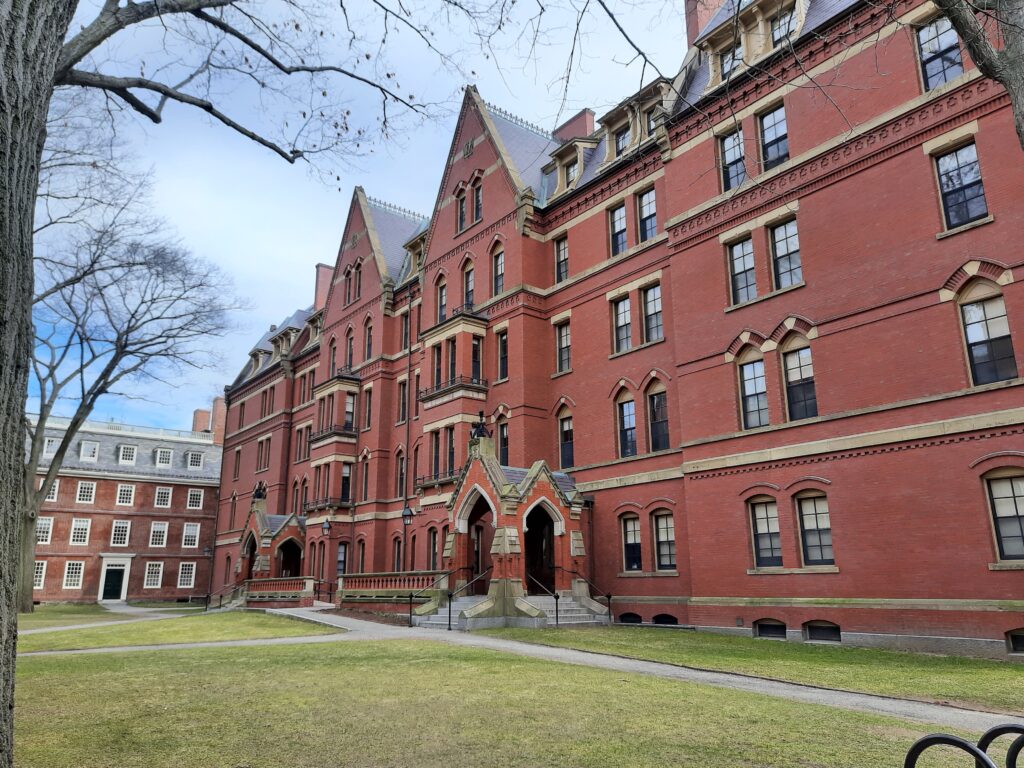
A top-ranked Ivy League institution, Harvard University also has a cultural diversity essay as part of its college application requirements:
Harvard has long recognized the importance of student body diversity of all kinds. We welcome you to write about distinctive aspects of your background, personal development, or the intellectual interests you might bring to your Harvard classmates.
Johns hopkins university.
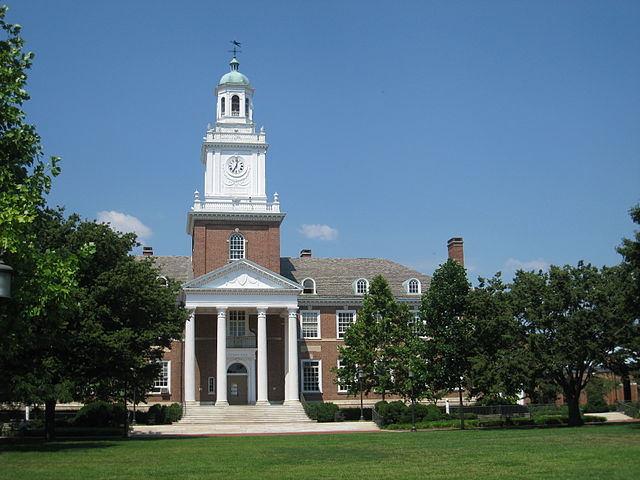
The Johns Hopkins supplement is another example of a cultural diversity essay:
Founded in the spirit of exploration and discovery, Johns Hopkins University encourages students to share their perspectives, develop their interests, and pursue new experiences. Use this space to share something you’d like the admissions committee to know about you (your interests, your background, your identity, or your community), and how it has shaped what you want to get out of your college experience at Hopkins.
University of michigan.
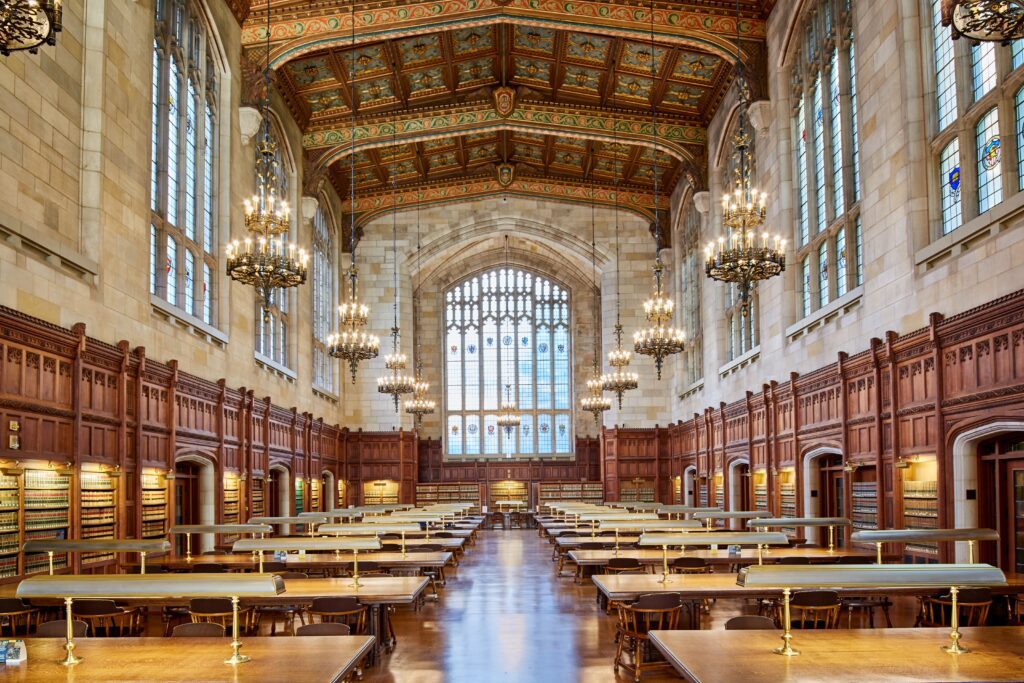
The University of Michigan requires a community essay for its application:
Everyone belongs to many different communities and/or groups defined by (among other things) shared geography, religion, ethnicity, income, cuisine, interest, race, ideology, or intellectual heritage. Choose one of the communities to which you belong and describe that community and your place within it.
Community essay examples.
The Duke and Michigan prompts are perfect illustrations of community essay examples. However, they have some critical differences. So, if you apply to both of these schools, you’ll have to change the way you approach either of these community essays.
The Duke prompt asks you to highlight why you are a good match for the Duke community. You’ll also see this prompt in other community essay examples. To write a successful response to this prompt, you’ll need to reference offerings specific to Duke (or whichever college requires this essay). In order to know what to reference, you’ll need to do your research before you start writing.
Consider the following questions as you write your diversity essay sample if the prompt is similar to Duke University’s
- What values does this college community have?
- How do these tie in with what you value?
- Is there something that this college offers that matches your interests, personality, or background?
On the other hand, the Michigan essay prompt asks you to describe a community that you belong to as well as your place within that community. This is another variation of the prompt for community essay examples.
To write a successful response to this prompt, you’ll need to identify a community that you belong to. Then, you’ll need to think critically about how you interact with that community.
Below are some questions to consider as you write your diversity essay sample for colleges like Michigan:
- Out of all the communities you belong to, which can you highlight in your response?
- How have you impacted this community?
- How has this community impacted you?
Now, in the next few sections, we’ll dive into the Georgetown supplemental essay examples, the Rice university essay examples, and the Williams supplemental essays examples. After each diversity essay sample, we’ll include a breakdown of why these are considered college essays that worked.
Georgetown Essay Examples
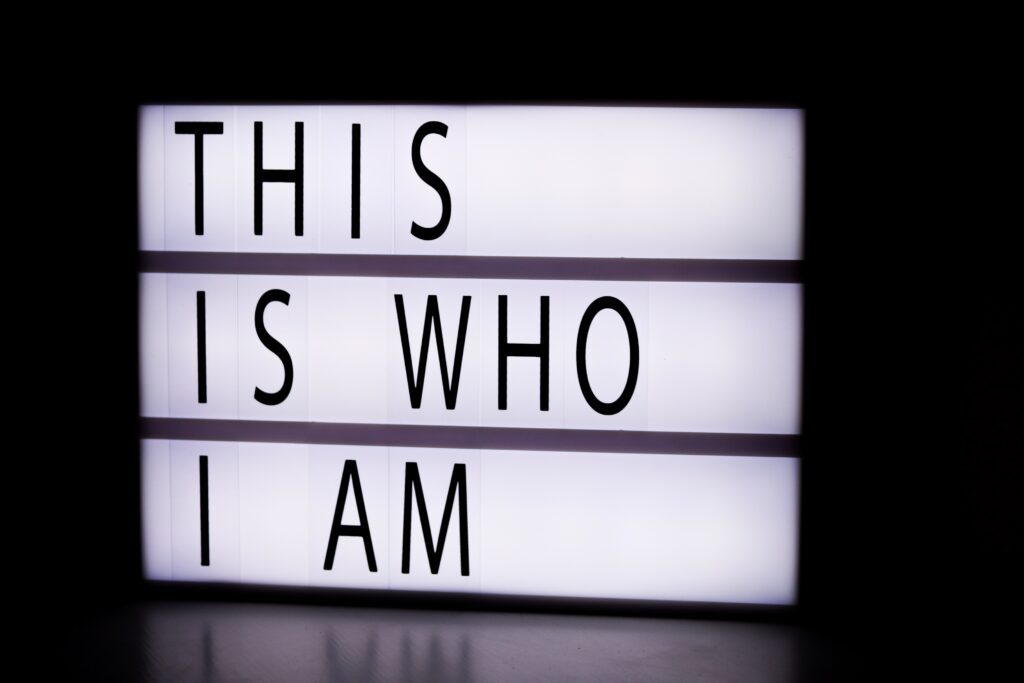
As a reminder, the Georgetown essay examples respond to this prompt:
As Georgetown is a diverse community, the Admissions Committee would like to know more about you in your own words. Please submit a brief essay, either personal or creative, which you feel best describes you.
Here is the excerpt of the diversity essay sample from our Georgetown essay examples:
Georgetown University Essay Example
The best thing I ever did was skip eight days of school in a row. Despite the protests of teachers over missed class time, I told them that the world is my classroom. The lessons I remember most are those that took place during my annual family vacation to coastal Maine. That rural world is the most authentic and incredible classroom where learning simply happens and becomes exponential.
Years ago, as I hunted through the rocks and seaweed for seaglass and mussels, I befriended a Maine local hauling her battered kayak on the shore. Though I didn’t realize it at the time, I had found a kindred spirit in Jeanne. Jeanne is a year-round resident who is more than the hard working, rugged Mainer that meets the eye; reserved and humble in nature, she is a wealth of knowledge and is self-taught through necessity. With thoughtful attention to detail, I engineered a primitive ramp made of driftwood and a pulley system to haul her kayak up the cliff. We diligently figured out complex problems and developed solutions through trial and error.
After running out of conventional materials, I recycled and reimagined items that had washed ashore. We expected to succeed, but were not afraid to fail. Working with Jeanne has been the best classroom in the world; without textbooks or technology, she has made a difference in my life. Whether building a basic irrigation system for her organic garden or installing solar panels to harness the sun’s energy, every project has shown me the value of taking action and making an impact. Each year brings a different project with new excitement and unique challenges. My resourcefulness, problem solving ability, and innovative thinking have advanced under her tutelage.
While exploring the rocky coast of Maine, I embrace every experience as an unparalleled educational opportunity that transcends any classroom environment. I discovered that firsthand experience and real-world application of science are my best teachers. In school, applications of complex calculations and abstract theories are sometimes obscured by grades and structure. In Maine, I expand my love of science and renourish my curious spirit. I am a highly independent, frugal, resilient Mainer living as a southern girl in NC.
Why this essay worked
This is one of the Georgetown supplemental essay examples that works, and here’s why. The author starts the essay with an interesting hook, which makes the reader want to learn more about this person and their perspective.
Throughout the essay, the author illustrates their intellectual curiosity. From befriending Jeanne and creating a pulley system to engineering other projects on the rocky coast of Maine, the author demonstrates how they welcome challenges and work to solve problems.
Further, the author mentions values that matter to them—taking action and making an impact. Both facets are also part of Georgetown’s core values . By making these connections in their essay, the author shows the admissions committee exactly how they would be a great fit for the Georgetown community.
Finally, the author uses their experience in Maine to showcase their love of science, which is likely the field they will study at Georgetown. Like this writer, you should try to include most important parts of your identity into your essay. This includes things like life experiences, passions, majors, extracurricular activities for college, and more.
Rice University Essay Examples

The Rice University essay examples are from this prompt:
The quality of Rice’s academic life and the Residential College System are heavily influenced by the unique life experiences and cultural traditions each student brings. What personal perspective would you contribute to life at Rice? (500-word limit)
Rice university essay example.
Like every applicant, I also have a story to share. A story that makes me who I am and consists of chapters about my life experiences and adventures. Having been born in a different country, my journey to America was one of the most difficult things I had ever experienced. Everything felt different. The atmosphere, the places, the food, and especially the people. Everywhere I looked, I saw something new. Although it was a bit overwhelming, one thing had not changed.
The caring nature of the people was still prevalent in everyday interactions. I was overwhelmed by how supportive and understanding people were of one another. Whether it is race, religion, or culture, everyone was accepted and appreciated. I knew that I could be whoever I wanted to be and that the only limitation was my imagination. Through hard work and persistence I put my all in everything that I did. I get this work ethic from my father since he is living proof that anything can be accomplished with continued determination. Listening to the childhood stories he told me, my dad would reminisce about how he was born in an impoverished area in a third world country during a turbulent and unpredictable time.
Even with a passion for learning, he had to work a laborious job in an attempt to help his parents make ends meet. He talked about how he would study under the street lights when the power went out at home. His parents wanted something better for him, as did he. Not living in America changed nothing about their work ethic. His parents continued to work hard daily, in an attempt to provide for their son. My dad worked and studied countless hours, paying his way through school with jobs and scholarships. His efforts paid off when he finally moved to America and opened his own business. None of it would have been possible without tremendous effort and dedication needed for a better life, values that are instilled within me as well, and this is the perspective that I wish to bring to Rice.
This diversity essay sample references the author’s unique life experiences and personal perspective, which makes it one example of college essays that worked. The author begins the essay by alluding to their unique story—they were born in a different country and then came to America. Instead of facing this change as a challenge, the author shows how this new experience helped them to feel comfortable with all kinds of people. They also highlight how their diversity was accepted and appreciated.
Additionally, the author incorporates information about their father’s story, which helps to frame their own values and where those values came from. The values that they chose to highlight also fall in line with the values of the Rice community.
Williams Supplemental Essay Examples

Let’s read the prompt that inspired so many strong Williams supplemental essays examples again:
Every first-year student at Williams lives in an Entry—a thoughtfully constructed microcosm of the student community that’s a defining part of the Williams experience. From the moment they arrive, students find themselves in what’s likely the most diverse collection of backgrounds, perspectives and interests they’ve ever encountered. What might differentiate you from the 19 other first-year students in an entry? What perspective(s) would you add to the conversation with your peers?
Williams college essay example.
Through the flow in my head
See you clad in red
But not just the clothes
It’s your whole being
Covering in this sickening blanket
Of heat and pain
Are you in agony, I wonder?
Is this the hell they told me about?
Have we been condemned?
Reduced to nothing but pain
At least we have each other
In our envelopes of crimson
I try in vain
“Take my hands” I shriek
“Let’s protect each other,
You and me, through this hell”
My body contorts
And deforms into nothingness
You remain the same
Clad in red
With faraway eyes
You, like a statue
Your eyes fixed somewhere else
You never see me
Just the red briefcase in your heart
We aren’t together
It’s always been me alone
While you stand there, aloof, with the briefcase in your heart.
I wrote this poem the day my prayer request for the Uighur Muslims got denied at school. At the time, I was stunned. I was taught to have empathy for those around me. Yet, that empathy disappears when told to extend it to someone different. I can’t comprehend this contradiction and I refuse to.
At Williams, I hope to become a Community Engagement Fellow at the Davis Center. I hope to use Williams’ support for social justice and advocacy to educate my fellow classmates on social issues around the world. Williams students are not just scholars but also leaders and changemakers. Together, we can strive to better the world through advocacy.
Human’s capability for love is endless. We just need to open our hearts to everyone.
It’s time to let the briefcase go and look at those around us with our real human eyes.
We see you now. Please forgive us.
As we mentioned above, the Williams acceptance rate is incredibly low. This makes the supplemental essay that much more important.
This diversity essay sample works because it is personal and memorable. The author chooses to start the essay off with a poem. Which, if done right, will immediately grab the reader’s attention.
Further, the author contextualizes the poem by explaining the circumstances surrounding it—they wrote it in response to a prayer request that was denied at school. In doing so, they also highlight their own values of empathy and embracing diversity.
Finally, the author ends their cultural diversity essay by describing what excites them about Williams. They also discuss how they see themselves interacting within the Williams community. This is a key piece of the essay, as it helps the reader understand how the author would be a good fit for Williams.
The examples provided within this essay also touch on issues that are important to the author, which provides a glimpse into the type of student the author would be on campus. Additionally, this response shows what potential extracurricular activities for college the author might be interested in pursuing while at Williams.
How to Write a Cultural Diversity Essay
You want your diversity essay to stand out from any other diversity essay sample. But how do you write a successful cultural diversity essay?
First, consider what pieces of your identity you want to highlight in your essay. Of course, race and ethnicity are important facets of diversity. However, there are plenty of other factors to consider.
As you brainstorm, think outside the box to figure out what aspects of your identity help make up who you are. Because identity and diversity fall on a spectrum, there is no right or wrong answer here.
Fit your ideas to the specific school
Once you’ve decided on what you want to represent in your cultural diversity essay, think about how that fits into the college of your choice. Use your cultural diversity essay to make connections to the school. If your college has specific values or programs that align with your identity, then include them in your cultural diversity essay!
Above all, you should write about something that is important to you. Your cultural diversity essay, gender diversity essay, or community essay will succeed if you are passionate about your topic and willing to get personal.
Additional Tips for Community & Cultural Diversity Essays

1. Start Early
In order to create the strongest diversity essay possible, you’ll want to start early. Filling out college applications is already a time-consuming process. So, you can cut back on additional stress and anxiety by writing your cultural diversity essay as early as possible.
2. Brainstorm
Writing a cultural diversity essay or community essay is a personal process. To set yourself up for success, take time to brainstorm and reflect on your topic. Overall, you want your cultural diversity essay to be a good indication of who you are and what makes you a unique applicant.
3. Proofread
We can’t stress this final tip enough. Be sure to proofread your cultural diversity essay before you hit the submit button. Additionally, you can read your essay aloud to hear how it flows. You can also can ask someone you trust, like your college advisor or a teacher, to help proofread your essay as well.
Other CollegeAdvisor Essay Resources to Explore
Looking for additional resources on supplemental essays for the colleges we mentioned above? Do you need help with incorporating extracurricular activities for college into your essays or crafting a strong diversity essay sample? We’ve got you covered.
Our how to get into Georgetown guide covers additional tips on how to approach the supplemental diversity essay. If you’re wondering how to write about community in your essay, check out our campus community article for an insider’s perspective on Williams College.
Want to learn strategies for writing compelling cultural diversity essays? Check out this Q&A webinar, featuring a former Georgetown admissions officer. And, if you’re still unsure of what to highlight in your community essay, try getting inspiration from a virtual college tour .
Cultural Diversity Essay & Community Essay Examples – Final Thoughts
Your supplemental essays are an important piece of the college application puzzle. With colleges becoming more competitive than ever, you’ll want to do everything you can to create a strong candidate profile. This includes writing well-crafted responses for a cultural diversity essay, gender diversity essay, or community essay.
We hope our cultural diversity essay guide helped you learn more about this common type of supplemental essay. As you are writing your own cultural diversity essay or community essay, use the essay examples from Georgetown, Rice, and Williams above as your guide.
Getting into top schools takes a lot more than a strong resume. Writing specific, thoughtful, and personal responses for a cultural diversity essay, gender diversity essay, or community essay will put you one step closer to maximizing your chances of admission. Good luck!
CollegeAdvisor.com is here to help you with every aspect of the college admissions process. From taking a gap year to completing enrollment , we’re here to help. Register today to receive one-on-one support from an admissions expert as you begin your college application journey.

This essay guide was written by senior advisor, Claire Babbs . Looking for more admissions support? Click here to schedule a free meeting with one of our Admissions Specialists. During your meeting, our team will discuss your profile and help you find targeted ways to increase your admissions odds at top schools. We’ll also answer any questions and discuss how CollegeAdvisor.com can support you in the college application process.
Personalized and effective college advising for high school students.
- Advisor Application
- Popular Colleges
- Privacy Policy and Cookie Notice
- Student Login
- California Privacy Notice
- Terms and Conditions
- Your Privacy Choices
By using the College Advisor site and/or working with College Advisor, you agree to our updated Terms and Conditions and Privacy Policy , including an arbitration clause that covers any disputes relating to our policies and your use of our products and services.
Calculate for all schools
Your chance of acceptance, your chancing factors, extracurriculars, searching for college community essay examples.
Hey everyone, I'm in the process of writing my college essays and I'd really like to see some examples of successful community essays. Has anyone found a good resource to help with this? I want to get a feel for what makes a strong essay in this particular category. Thanks!
Hello! It's awesome that you're working on your college essays and seeking inspiration for the community essay genre. A well-written community essay can effectively showcase your engagement and impact within your community, which is what colleges are looking for.
There are several resources online where you can find examples of successful college essays, including community essays. I recommend taking a look at some of these websites:
1. CollegeVine: CollegeVine offers free essay guidance and advice on their blog, where they also post successful essays written by students who were admitted to top colleges. You can search their blog for community essay examples, along with articles on common essay topics and tips for writing a solid application essay.
2. College Essay Guy: This website features a wide variety of college essays, including community essays. You can find successful examples on the site along with detailed analysis and feedback to help you understand what makes them successful.
3. New York Times: The NYT puts out an annual article showcasing some of the strongest college essays submitted for that year, often covering a diverse range of topics, including community-focused essays. You can check their archives for this article series.
Remember, while it's important to look at examples for inspiration, be careful not to directly imitate or copy the style or content of other essays. Your own voice and unique experiences are what will make your essay stand out.
Finally, as you're searching for examples and brainstorming ideas, think about the specific aspects of your community and the impact you've made on others. Consider your role, the actions you've taken, and any challenges you've faced. These details will help you to create a compelling community essay that highlights your personal growth and commitment to your community.
Good luck with your essay-writing process!
About CollegeVine’s Expert FAQ
CollegeVine’s Q&A seeks to offer informed perspectives on commonly asked admissions questions. Every answer is refined and validated by our team of admissions experts to ensure it resonates with trusted knowledge in the field.

Community College Essay

Picture this situation: You are a fresh graduate from high school. You prefer to take the time off before going to university, but you also need to get a job to support yourself. Knowing the fact that if you are planning to apply for a job, you would need experience, and a degree. But you prefer to take the time off first. This can be a conflict since you are torn between wanting to take the time off and looking for a job that pays for you to support yourself. What should be the best option for you at this point? Some would tell you to immediately go to university and get a four year degree and work from there.
Others may say, why not go to community college? Where you can get a two year degree compared to a four year degree. If you prefer to continue from there, you can proceed to university after a while. To the people who do prefer to attend community college go ahead. Do it. But just like any other university or college, there are some requirements that you have to meet to get in. One requirement they may ask of you is an essay . An application essay. If you think writing a community college essay is difficult, don’t worry, this article has you covered.
10+ Community College Essay Examples
1. community college application essay.
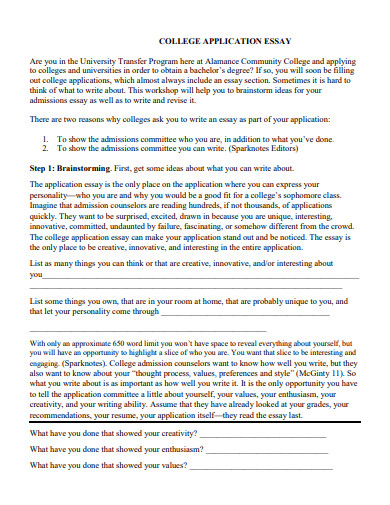
Size: 281 KB
2. Community Service College Essay
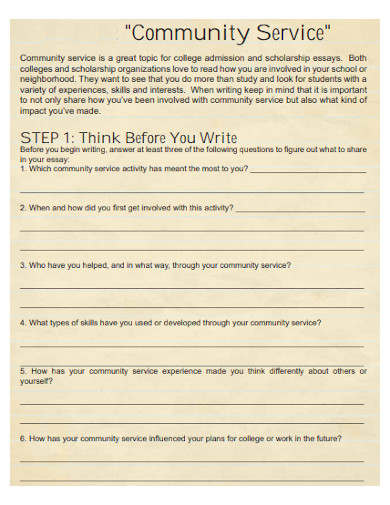
Size: 94 KB
3. Printable Community College Essay
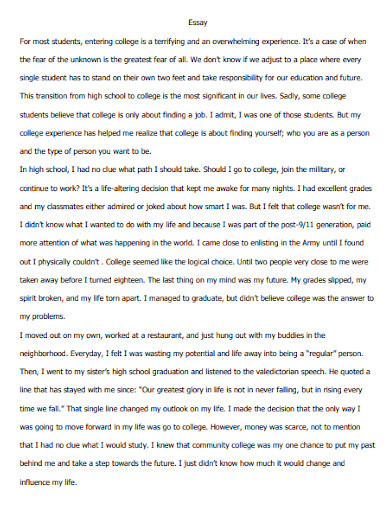
Size: 57 KB
4. Community College Experience Essay
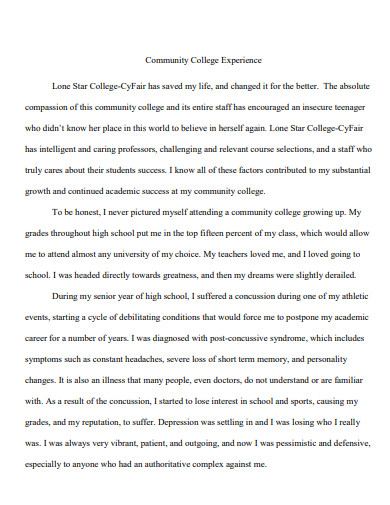
Size: 39 KB
5. Community College Admission Essay

Size: 374 KB
6. Editable Community College Essay
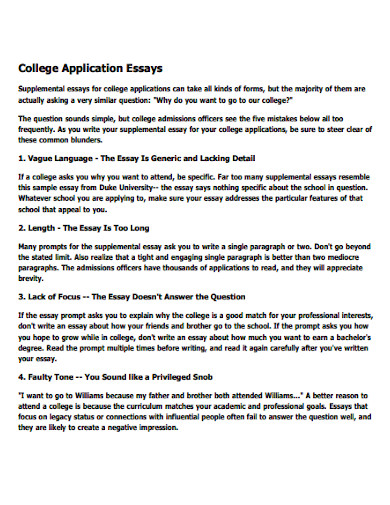
Size: 48 KB
7. Community Scholarship College Essay
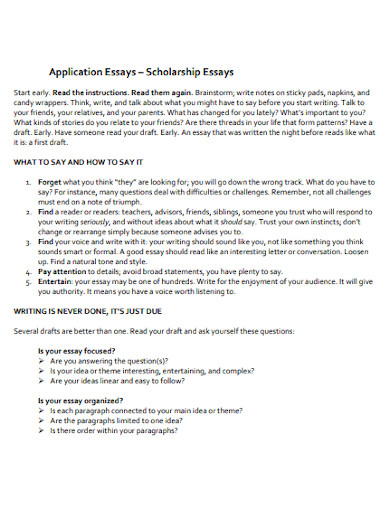
Size: 257 KB
8. Community College Campus Essay
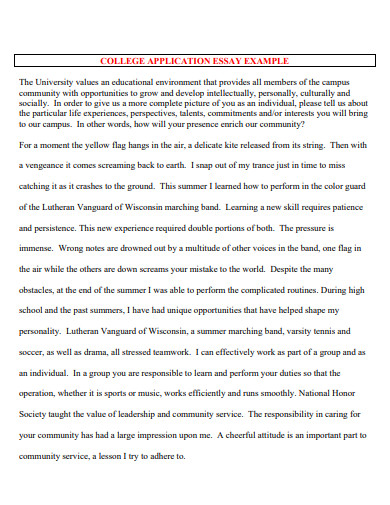
Size: 19 KB
9. Community College Assessment Essay
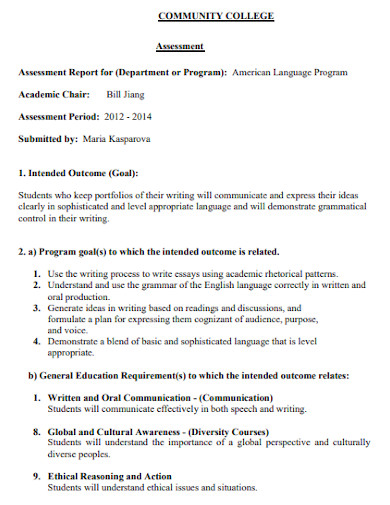
Size: 167 KB
10. Community College Essay Contest
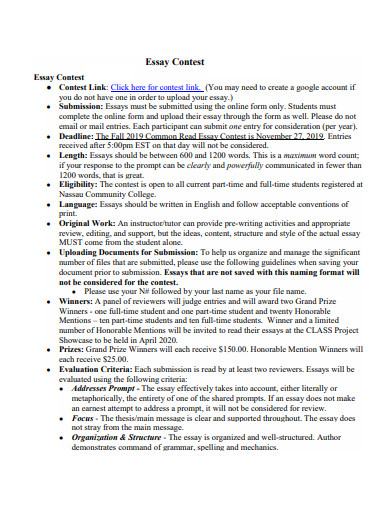
Size: 403 KB
11. Community College Essay Glance
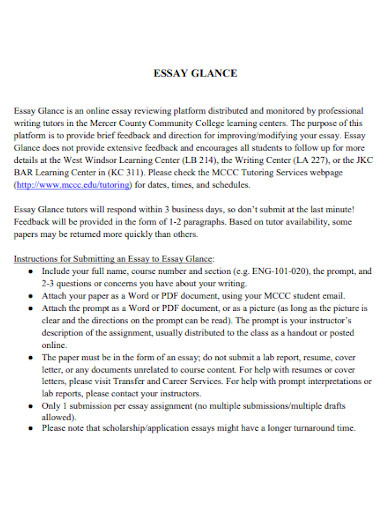
Size: 107 KB
What Is a Community College Essay?
A community college essay is a kind of application essay that you write in order to apply for a spot in a community college. This kind of essay is basically like any kind of application essay that an applicant would want to write to get accepted in a school, a university or for this case a college. The community college essay consists of the introduction, the body and the conclusion. What you write in your essay would mostly fall on the basics. Who you are , why did you choose this college, what program are you planning on taking, the reason why and some skills you may want to learn while going through college.
These are basically the most common information that you are going to be adding when writing that essay. In addition to that, a community college essay also helps the college committee get a glimpse of who you are as a person. The purpose of a community college essay is for the committee to get to know the applicant. To see if this applicant fits the requirements they are giving out to anyone who may want to attend the school. As well as it is common knowledge for anyone who wishes to apply to a college or university that they must undergo a college application essay.
How to Write a Community College Essay?
Are you up for the challenge of writing a good community college essay? I know a lot of people say that writing essays is difficult. Writing a community college application essay is more difficult because you don’t know where to begin. Let me tell you that it is not as difficult as others may perceive it to be. Here are some tips to help you. Check them out now.
1. Begin With an Anecdote or a Question
What better way to start your essay than to add an anecdote or a question. This is used to draw your readers in to reading your essay. If you plan to use an anecdote, find an appropriate anecdote that would also match your essay. Avoid using anecdotes that may end up as a misunderstanding. The same goes for the question you are planning on using.
2. Tell Them Who You Are and the Name of the Program
Introducing yourself in your essay is one of the main things that goes on with the community college essay. Tell them your name, and the program you plan on taking up and why. This gives them a chance to get to know you in a level that makes them curious. However, when you do introduce yourself in the essay, make it unique and not generic. Because even in essays, people have ways of knowing the vibe they may get from you.
3. Make It as Personal as You Can
A continuation of the second tip, when you introduce yourself or when you continue writing your essay, make sure to make it as personal as you can. This means that you avoid writing a generic essay that may sound like you simply copied something down. To make your essay stand out, make it personal. Show your readers or the audience who you are when writing. Talk to them through your words. Show them the side of you that you rarely show. Not only will this make your essay stand out, it would also be easy for the committee to see that this person writing is a real person. That this is their life and their dreams of entering community college.
4. Explain Your Reason for Wanting the Program
Just as you continue on writing this essay, you should also add to the point of explaining why you want to apply for the program. Give your reasons, and as much as possible, be honest. The committee would understand perfectly for you choosing the program you want to graduate from. As long as you understand and did your research before accepting to take the program. This also shows that you are aware and willing to know more about the program before applying for college.
5. Rewrite Your Essay if Necessary
Just like writing any kind of essay, you must always proofread before sending. This is a helpful tool to help you recheck. To see if there is anything you may have missed, grammar errors that need to be fixed and spelling that need to be redone. Once you are sure, you may go ahead and pass the essay.
What is a community college essay?
A community college essay is a kind of essay that is used in a way to apply for a program in college. It gives you the opportunity to introduce yourself and show the committee of the school that you are interested in being a student there.
How long is an application essay?
Around 500 to 700 words, and a whole page essay is the best option when writing your essay. Not too short nor too lengthy.
What should not be written in an essay?
Avoid writing a generic type of essay. Committees of the college often encourage applicants to write a genuine essay rather than a generic essay. This is easier for them to get to know you if you write it on a personal level.
Now that you know what a community college essay is and how it is written, do you think it is still as difficult as others would say? If you still think it is, the best advice is to practice. Practicing how to write an application essay would not only be useful for you in the end, but it is also a good way to appreciate a good application essay for college.
Community College Essay Generator
Text prompt
- Instructive
- Professional
Explain why community colleges are a valuable option for higher education in your Community College Essay.
Discuss the diverse opportunities available at community colleges and how they can benefit students in your Community College Essay.
Home — Essay Samples — Sociology — Individual and Society — Discourse Community
Essays on Discourse Community
Engaging discourse community essay prompts.
Finding the right prompt can set the stage for an insightful essay. Here are some thought-provoking prompts to get you started:
- Evaluate the discourse within an online forum dedicated to sustainability.
- Analyze the communication patterns of a professional esports team.
- Investigate how a local art collective uses language to build community.
Picking a Standout Discourse Community Essay Topic
Choosing a compelling topic is crucial. Here’s how to make sure you land on something engaging:
- Interest : Opt for a community you’re personally interested in or curious about.
- Originality : Seek out topics that aren’t overdone. The more unique, the better.
- Accessibility : Make sure you can access enough information and resources for your essay.
Examples of Discourse Community Essay Topics
To avoid the usual suspects and spark your imagination, consider these unique essay topics:
- Discourse practices in online coding bootcamps.
- Language and identity in expatriate communities.
- How DIY forums challenge traditional expertise.
- Discourse dynamics in feminist activist groups.
- The role of language in local food cooperatives.
- Communication styles within virtual reality spaces.
- Analysis of discourse in mental health support groups.
- Language use in underground music communities.
- How digital nomads create community through discourse.
- Discourse among members of a city council.
- Cross-cultural communication in international business teams.
- Language and power in academic departments.
- Communication strategies in environmental advocacy groups.
- Discourse in online platforms for language learning.
- Community building in co-living spaces.
- Discourse strategies in political campaigning.
- Role of language in crafting a makerspace identity.
- Online forums as spaces for medical discourse.
- Language evolution in multiplayer online games.
- Building a discourse community in coworking spaces.
Inspiration for Your Discourse Community Essay
Need a nudge to get your writing process started? Let these ideas inspire you:
"Exploring the esports team's communication reveals a complex system of language, symbols, and rituals, highlighting the nuanced ways members create a sense of belonging and identity."
"The vibrant discourse within the feminist activist group not only challenges societal norms but also fosters a strong sense of community and shared purpose among its members."
Understanding and Examples of a Discourse Community
"discourse community" by john swales: summary, made-to-order essay as fast as you need it.
Each essay is customized to cater to your unique preferences
+ experts online
Discourse Community
My experiences in volleyball discourse community, analysis of a discourse community: craft and diy enthusiasts, the game super smash bros. melee's community as an example of a discourse community, let us write you an essay from scratch.
- 450+ experts on 30 subjects ready to help
- Custom essay delivered in as few as 3 hours
The Discourse Community of Hypebeasts
Six characteristics that can be used to identify what qualifies as a discourse community, a reflection paper on football discourse community, research on discourse community of a small start-up business, get a personalized essay in under 3 hours.
Expert-written essays crafted with your exact needs in mind
Authority Within a Discourse Community: Personal Reflection
Rhetorical methods in the finance and economics discourse communities, critical discourse analysis and power relations, critical discourse analysis of race and racism, critical discourse analysis: historical origins, analyzing gender stereotypes, and empowerment in the always campaign, gender diffrences in political discourse, discourse community practices.
A discourse community refers to a collective of individuals who possess a shared set of discourses, encompassing fundamental values, assumptions, and modes of communication that revolve around common objectives.
A discourse community exhibits distinct characteristics that define its identity and functioning. Firstly, they have a common goal or purpose that unites members and serves as a focal point for their interactions. This shared objective creates a sense of belonging and facilitates effective communication within the community. Secondly, discourse communities have specific language and communication practices unique to their group. These can include specialized terminology, jargon, or even non-verbal cues that enable efficient and meaningful communication among members. Mastery of this shared language is crucial for individuals to participate actively and contribute to the community's discourse. Thirdly, discourse communities often possess established conventions, norms, and expectations regarding appropriate behavior, ethics, and standards of communication. These guidelines ensure cohesion, cooperation, and mutual respect among members. Lastly, discourse communities may have gatekeepers who regulate access and maintain the integrity of the community. These gatekeepers may be experts, mentors, or long-standing members who ensure that new participants meet the community's requirements and contribute positively to its ongoing discourse.
The concept of discourse community emerged as a framework in the field of sociolinguistics and discourse analysis. Although there is no specific historical origin attributed to it, the study of discourse communities can be traced back to the works of scholars such as John Swales and James Gee in the late 20th century. John Swales, a prominent linguist, introduced the term "discourse community" in his influential book "Genre Analysis: English in Academic and Research Settings" published in 1990. Swales emphasized the importance of understanding the communicative practices and conventions within specific communities to effectively participate in their discourse. James Gee, another influential scholar, expanded the concept of discourse community and introduced the idea of "situated learning" in his book "Social Linguistics and Literacies: Ideology in Discourses" published in 1996. Gee explored how discourse communities shape identity, knowledge acquisition, and socialization processes. Since then, the study of discourse communities has gained prominence in various fields, including linguistics, communication studies, and sociology.
1. Professional Discourse Communities. 2. Academic Discourse Communities. 3. Hobbyist Discourse Communities. 4. Cultural Discourse Communities. 5. Online Discourse Communities:
Academic Discourse Community: Scholars, researchers, and students within a specific discipline form an academic discourse community. They share specialized knowledge, use discipline-specific terminology, and engage in scholarly writing and discussions. Online Gaming Community: Gamers who participate in online multiplayer games create a discourse community. They use game-specific jargon, communicate through forums or chat platforms, and share strategies and experiences related to gaming. Professional Discourse Community: Professions such as medicine, law, or engineering have their own discourse communities. Professionals within these fields communicate using technical terminology, share professional experiences, and adhere to specific codes of conduct. Sports Fan Community: Fans of a particular sports team or sport create a discourse community. They engage in discussions, debates, and analyses of games and players, often using sports-related slang and terms. Social Media Community: Users of social media platforms form discourse communities based on shared interests, such as fashion, food, or photography. They communicate through hashtags, comments, and posts, creating a unique community around their shared topics.
Social Construction of Reality, Situated Learning Theory, Communities of Practice, Genre Theory.
The study of discourse communities holds significant importance as it sheds light on the intricate ways in which individuals and groups interact, communicate, and form shared understandings within specific contexts. Understanding discourse communities allows us to recognize and appreciate the diversity of social groups and their unique discursive practices, values, and goals. Exploring discourse communities helps us comprehend how language shapes social interactions, knowledge construction, and the formation of identities. It allows us to identify the power dynamics and hierarchies that exist within these communities and how they influence individuals' access to resources and opportunities for participation. Moreover, discourse communities play a crucial role in the transmission and dissemination of knowledge, expertise, and cultural practices. By studying discourse communities, we gain insights into how knowledge is constructed, shared, and preserved within specific fields or domains.
The topic of discourse communities is a compelling subject for an essay due to its relevance and wide-ranging implications in various fields of study. By delving into discourse communities, one can explore the intricate ways in which language, communication, and social interaction shape our understanding of the world. Writing an essay on discourse communities allows for an in-depth examination of how different communities form, develop shared understandings, and create meaning through their discursive practices. It offers an opportunity to analyze the power dynamics, norms, and values that influence communication within specific groups. Furthermore, studying discourse communities provides insights into knowledge transmission, expertise, and identity formation. It allows for a critical exploration of the role of language in shaping social relationships, access to resources, and opportunities for participation within specific communities.
1. Gee, J. P. (1996). Social linguistics and literacies: Ideology in discourses. Routledge. 2. Swales, J. M. (1990). Genre analysis: English in academic and research settings. Cambridge University Press. 3. Johns, A. M. (1997). Text, role, and context: Developing academic literacies. Cambridge University Press. 4. Prior, P. (1998). Writing/disciplinarity: A sociohistoric account of literate activity in the academy. Routledge. 5. Bazerman, C. (2004). Speech acts, genres, and activity systems: How texts organize activity and people. Routledge. 6. Miller, C. R. (1984). Genre as social action. Quarterly Journal of Speech, 70(2), 151-167. 7. Bhatia, V. K. (2004). Worlds of written discourse: A genre-based view. Continuum. 8. Barton, D., & Hamilton, M. (1998). Local literacies: Reading and writing in one community. Routledge. 9. Paltridge, B. (2001). Genre, frames and writing in research settings. John Benjamins Publishing. 10. Johns, A. M. (2017). Discourse communities and communities of practice. In T. Johnstone (Ed.), The Cambridge handbook of discourse studies (pp. 257-273). Cambridge University Press.
Relevant topics
- Social Justice
- Effects of Social Media
- American Identity
- Sex, Gender and Sexuality
- Media Analysis
- Sociological Imagination
- Social Media
- Cultural Appropriation
By clicking “Check Writers’ Offers”, you agree to our terms of service and privacy policy . We’ll occasionally send you promo and account related email
No need to pay just yet!
We use cookies to personalyze your web-site experience. By continuing we’ll assume you board with our cookie policy .
- Instructions Followed To The Letter
- Deadlines Met At Every Stage
- Unique And Plagiarism Free
The Case of Tinker V. Des Moines School District
This essay is about the landmark Supreme Court case Tinker v. Des Moines Independent Community School District, which established the First Amendment rights of students in public schools. In 1969, the Court ruled that students do not lose their constitutional rights to free speech when they enter school, provided their actions do not cause substantial disruption. The case originated when students, including Mary Beth and John Tinker, wore black armbands to protest the Vietnam War and were suspended. The ruling set the “Tinker Test” for determining when student speech is protected. This decision has had a lasting impact on student activism and free speech, influencing subsequent cases and ongoing debates about the balance between school authority and individual rights.
How it works
In the American jurisprudence, the case of Tinker v. Des Moines Independent Community School District stands as a monumental juncture, particularly concerning the First Amendment entitlements of pupils. Rendered by the United States Supreme Court in 1969, this landmark verdict established a pivotal precedent dictating the scope of students’ free speech privileges in public educational institutions. The judgment underscored the immutable tenet that neither students nor educators relinquish their constitutional rights to vocal or expressive liberties upon crossing the threshold of the educational edifice.
The genesis of the legal saga traces back to December 1965, amid the burgeoning anti-war sentiment during the Vietnam conflict. A cadre of pupils in Des Moines, Iowa, among them Mary Beth Tinker, her sibling John Tinker, and their comrade Christopher Eckhardt, elected to don black armbands as a symbolic gesture of protest. Their objective was to mourn the fallen on both sides of the contentious war and advocate for a proposed Yuletide truce. Yet, school authorities swiftly imposed a directive proscribing the wearing of such armbands upon learning of the planned demonstration. Undeterred by this proscription, the Tinker siblings and Eckhardt adorned themselves with the armbands, precipitating their immediate suspension for contravening the new edict.
Convinced that their First Amendment prerogatives had been transgressed, the students, bolstered by parental support, resolved to contest the school district’s decree. The legal imbroglio eventually ascended to the apex court, confronting the justices with the pivotal query of whether the educational institution’s actions encroached upon the students’ constitutionally ordained freedom of expression.
In a seminal 7-2 ruling, the Supreme Court sided with the students. Delivering the majority opinion, Justice Abe Fortas averred that students do not “abdicate their constitutional rights to freedom of speech or expression at the schoolhouse gate.” The tribunal acknowledged that while schools possess the prerogative to preserve decorum, they may not stifle student expression absent demonstrable disruption to the educational milieu. In the Tinker case, no evidence surfaced indicating that the students’ tacit protest had precipitated any such upheaval. Consequently, the school district’s measures were deemed an unwarranted infringement upon the students’ liberties.
The Tinker edict established the precedent now dubbed the “Tinker Test” for assessing student speech. Under this litmus test, student expression is shielded by the First Amendment unless it engenders significant disruption or impinges upon the rights of others. This pronouncement exerted a profound influence on subsequent cases pertaining to student speech and expression, serving as a lodestar in judicial deliberations.
The Tinker v. Des Moines case resonates not only for its legal ramifications but also for its broader cultural resonance. The ruling emboldened students to partake in political and social dialogue within the scholastic milieu, engendering a culture of activism and engagement. It affirmed the premise that young individuals possess a voice, and their perspectives merit safeguarding. This assertion proved particularly salient during the tumultuous 1960s, an epoch characterized by profound social and political convulsions, including the civil rights crusade and widespread dissent against the Vietnam War.
In the aftermath of the Tinker verdict, the contours of student free speech have been delineated and tested through subsequent Supreme Court adjudications. For instance, in Bethel School District v. Fraser (1986), the Court sanctioned the suspension of a student for delivering a salacious oration at a school assembly. The Court differentiated this scenario from Tinker, accentuating schools’ authority to proscribe vulgar language to cultivate a safe and conducive academic milieu. Similarly, in Hazelwood School District v. Kuhlmeier (1988), the Court ruled that educational administrators possess the prerogative to wield editorial control over school-sponsored publications, provided such actions are germane to pedagogical imperatives. These rulings epitomize the delicate equilibrium the Court has endeavored to strike between safeguarding student expression and upholding school order and academic integrity.
Notwithstanding these limitations, the foundational tenet of Tinker—that students retain First Amendment rights that endure within scholastic precincts—endures as a keystone of student free speech jurisprudence. It continues to inform debates regarding the equilibrium between school authority and student liberties, encompassing issues such as student dress codes, social media utilization, and political demonstrations.
The cultural and societal reverberations of the Tinker decision transcend the courtroom. It has fostered heightened awareness among students regarding their constitutional prerogatives and has galvanized a more participatory and engaged student body. The verdict has inspired myriad students to advocate for causes they deem significant, cognizant that their voices enjoy protection. This empowerment has manifested in numerous student-led movements over the years, from anti-war protests in the 1960s and 1970s to contemporary campaigns advocating for gun control, environmental conservation, and social justice.
The legacy of Tinker v. Des Moines stands as a testament to the enduring imperative of safeguarding individual rights, even within regimented settings such as educational institutions. It underscores the imperative of balancing the authority of educational establishments with the foundational freedoms enshrined in the Constitution. By affirming that students do not forfeit their constitutional rights at the threshold of the schoolhouse, the Supreme Court affirmed the significance of nurturing a democratic ethos and fostering civic engagement from an early age.
In the contemporary milieu, the principles elucidated in the Tinker case retain salience. The proliferation of digital communication and social media platforms has engendered novel avenues for student expression, prompting fresh challenges and queries regarding the application of First Amendment safeguards. Educational institutions grapple with issues such as cyberbullying, online harassment, and the dissemination of disinformation, all while endeavoring to uphold students’ rights to unfettered expression. The Tinker Test endures as an indispensable tool in navigating these multifaceted dilemmas, furnishing a framework for discerning when curtailment of student speech is justified.
Moreover, the Tinker v. Des Moines case accentuates the role of the judiciary in safeguarding constitutional prerogatives. It serves as a reminder of the judiciary’s pivotal role in shielding individual freedoms from capricious or unjust state actions. The decision epitomizes the judiciary’s capacity to uphold democratic ideals and ensure that the rights enshrined in the Constitution are safeguarded for all citizens, including students.
Upon reflection, it becomes manifest that the Tinker saga transcended a mere protest concerning black armbands. It embodied a robust affirmation of individuals’ fundamental entitlements to articulate their convictions and viewpoints, even in the face of opposition. The fortitude exhibited by Mary Beth Tinker, John Tinker, and Christopher Eckhardt in vindicating their rights has indelibly shaped the legal landscape, empowering future cohorts of students.
In summation, the case of Tinker v. Des Moines Independent Community School District stands as a watershed moment that profoundly influenced the panorama of student rights in the United States. It reaffirmed the constitutional safeguards of free speech within public schools, subject to the constraint that such expression does not precipitate significant disruption. The verdict’s ramifications endure, nurturing a milieu of student activism and serving as a seminal precedent in ongoing discourses regarding the scope and constraints of student expression. The legacy of Tinker underscores the perennial exigency of shielding individual rights, even within regimented settings like schools. By affirming that students retain their constitutional rights at the threshold of the schoolhouse, the Supreme Court has ensured that the voices of youth persist in being heard and respected.
Cite this page
The Case of Tinker v. Des Moines School District. (2024, May 21). Retrieved from https://papersowl.com/examples/the-case-of-tinker-v-des-moines-school-district/
"The Case of Tinker v. Des Moines School District." PapersOwl.com , 21 May 2024, https://papersowl.com/examples/the-case-of-tinker-v-des-moines-school-district/
PapersOwl.com. (2024). The Case of Tinker v. Des Moines School District . [Online]. Available at: https://papersowl.com/examples/the-case-of-tinker-v-des-moines-school-district/ [Accessed: 23 May. 2024]
"The Case of Tinker v. Des Moines School District." PapersOwl.com, May 21, 2024. Accessed May 23, 2024. https://papersowl.com/examples/the-case-of-tinker-v-des-moines-school-district/
"The Case of Tinker v. Des Moines School District," PapersOwl.com , 21-May-2024. [Online]. Available: https://papersowl.com/examples/the-case-of-tinker-v-des-moines-school-district/. [Accessed: 23-May-2024]
PapersOwl.com. (2024). The Case of Tinker v. Des Moines School District . [Online]. Available at: https://papersowl.com/examples/the-case-of-tinker-v-des-moines-school-district/ [Accessed: 23-May-2024]
Don't let plagiarism ruin your grade
Hire a writer to get a unique paper crafted to your needs.

Our writers will help you fix any mistakes and get an A+!
Please check your inbox.
You can order an original essay written according to your instructions.
Trusted by over 1 million students worldwide
1. Tell Us Your Requirements
2. Pick your perfect writer
3. Get Your Paper and Pay
Hi! I'm Amy, your personal assistant!
Don't know where to start? Give me your paper requirements and I connect you to an academic expert.
short deadlines
100% Plagiarism-Free
Certified writers
What are your chances of acceptance?
Calculate for all schools, your chance of acceptance.
Your chancing factors
Extracurriculars.
5 University of Washington Essay Examples by Accepted Students
What’s covered:, essay example #1 – diversity, cripplepunks, essay example #2 – diversity, community in difference, essay example #3 – diversity, food, essay example #4 – diversity, dinnertime conversations, essay example #5 – interdisciplinary studies, where to get your university of washington essays edited.
The University of Washington is a selective school, so it’s important to write strong essays to help your application stand out. In this post, we’ll share essays real students have submitted to the University of Washington. (Names and identifying information have been changed, but all other details are preserved).
Read our University of Washington es say breakdown to get a comprehensive overview of this year’s supplemental prompts.
Please note: Looking at examples of real essays students have submitted to colleges can be very beneficial to get inspiration for your essays. You should never copy or plagiarize from these examples when writing your own essays. Colleges can tell when an essay isn’t genuine and will not view students favorably if they plagiarized.
Prompt: Our families and communities often define us and our individual worlds. Community might refer to your cultural group, extended family, religious group, neighborhood or school, sports team or club, co-workers, etc. Describe the world you come from and how you, as a product of it, might add to the diversity of the University of Washington. (300 words)
The first time I looked up the term cripplepunk I was in ninth grade, almost bedbound with severe hip pain. It took half a second for the page to load, and another half a second for me to process what I was seeing. There before me, against the muted grey of my phone’s dark mode, is the community I thought I would never have. I could have scrolled for hours, absorbing the images of models in powerchairs wearing ornate gowns, snarky patches on guide dog vests, and decorated canes. I kept coming back to the page, enchanted with the movement. Although the term cripplepunk wasn’t used until 2014, the spirit of the movement is present in most disabled people, from Frida Kahlo to the participants in the Capitol Crawl. The cripplepunk movement is intentionally subversive, fighting against the ableism and pity that disabled people encounter at every turn. Cripplepunks take a “so what if I am?” approach to ableism, refusing to be ashamed of symptoms, accommodations, or mobility aids. It’s a diverse movement too, where a 60-something veteran dealing with decades-old injuries can guide me through the process of buying and decorating my first cane. In cripplepunk circles, a deafblind Black woman can teach the world that disabled people can have dreams for their futures. The cripplepunk movement is a movement where I can offer sympathy, advice, and support to the same people who helped me through otherwise isolating moments and new cripples alike. That work doesn’t just happen online though. My work as a cripplepunk happens everywhere, classrooms and grocery stores alike, by being visibly and unashamedly disabled, vocally confronting ableists, and campaigning for greater accessibility.
What the Essay Did Well
One of the primary strengths of this “Diversity” essay is its writer’s enthusiasm about the cripplepunk movement, which helps readers feel connected to them. At the very beginning of this response, we are introduced to the term ‘cripplepunk,’ but just like the student, we are not exactly sure what it means. We go through the process of learning about the movement with the student as they bring to our minds “images of models in powerchairs wearing ornate gowns, snarky patches on guide dog vests, and decorated canes.” By bringing us along to their first introduction to cripplepunk, this student forms a connection between themself and the reader. We get “enchanted” alongside them.
At the same time, we get enchanted by the student, who positions themself as mature and insightful. As they describe how the cripplepunk movement wasn’t labeled until 2014 but “the spirit of the movement” existed long before, they address the ways that community doesn’t need to have a name to exist. They position community as anything that makes individuals not feel alone, then follow that description up with a definition of community as “people who help others through otherwise isolating moments.” This deeper reflection displays this student’s insightful-nature and maturity.
Finally, this essay’s structure works very nicely. It is simultaneously anecdotal and reflective, and, to top it all off, the student provides an image of them in “classrooms and grocery stores alike” showing off their diversity and their pride. The anecdote draws the reader in, while the reflection reveals this student’s personality and perspectives. Combined, the reader gets a good idea of who this student is and how they would fit into the campus community.
What Could Be Improved
The one thing this essay didn’t address was how this student will add to the diversity of the University of Washington. Although we get a good sense of the unique community this student came from and how it shaped them, we still want to know how they will contribute to their campus community. This student could have easily revised the last few sentences to say something along the lines of this:
“I intend to bring the cripplepunk movement with me to the University of Washington. I’ll proudly display myself on campus so I can teach my fellow classmates about disabilities and encourage other disabled students to be unashamed of who they are.”
Reworking the conclusion to discuss how they will take the lessons they have learned from being part of the cripplepunk community and share those lessons with a new community would show admissions officers exactly what this student would bring to campus. It doesn’t have to be an extensive response, but the essay should include some reference of University of Washington.
In my youth, I found solace in communities of my peers who shared portions of my identity; from speaking the same second languages to sharing similar tastes, I was quick to bond with those I was similar to.
When I moved to Oregon, I found myself miles away from these connections. My fragmented identity found little to attach to my peers. Inkling connections uprooted as I attended three different middle schools throughout my years. “Community” felt like a bubble I was floating upon, inherently a part of yet never fully immersed.
At the end of math class towards the middle of eighth grade, I felt a tap on my shoulder. A tall girl with glasses and a tooth gap stood behind.
“Do you want to sit with us at lunch today?”
Stemming from this small invitation, I found myself part of a community of peers with whom I never thought I could relate. Our interests diverged and collided in all regards; we were of different gender identities, sexual orientations, and ethnic backgrounds. While I was the only person of color in our friend group, I cherished the different experiences we brought to the table. I recounted my struggles accepting my culture while I heard the stories of my friends who were dealing with gender dysphoria.
In the following years, I wholeheartedly applied this multifaceted outlook to my sense of community. I engaged with peers both different and similar to me; I found community at Indian festivals with my fellow South Asian peers and community with my closest friends with whom I can form strong emotional connections, despite our dissimilar backgrounds.
This ever-growing sense of community has helped me thrive and will better help me engage within the student body at the University of Washington
As this student explores the struggle of finding community, their essay not only reads like a Diversity essay but also like an Overcoming Challenges essay .
The main strength of this essay is the arc it presents. We learn about their background (moving around a lot) and we learn that community didn’t always come easy for them. The sentence “‘ Community’ felt like a bubble I was floating upon, inherently a part of yet never fully immersed” articulates their isolation particularly well. At the same time, this sentence shows their profound awareness of the true meaning of community. They understand that being a part of a formal group like a school organization, an ethnic group, or a sport does not necessarily mean one feels community.
As the essay progresses, the student comes to understand that community does not have to exist within any formal bounds at all. You can find community with people completely different from you. Through their reflection, this student clearly shows an understanding of the importance of diversity. Not only is this essay able to demonstrate the meaning of community to this student, but it also displays how diversity is an integral part of community, which is exactly what admissions officers want to see.
The beginning of this essay is a little slow, so the whole essay would benefit from reordering it and changing the structure a bit. Essays tend to start off with an anecdote to hook the reader and then go into more elaboration. However, it takes a few sentences before this student gets to their anecdote. We learn about this student’s experience feeling part of (or isolated from) a community prior to middle school, but the essay isn’t overly engaging before the anecdote.
The anecdote livens up the essay and brings a renewed sense of excitement and engagement to the reader, so opening the essay with the story of getting invited to lunch would spur that interest from the beginning. After the quick anecdote, the student could explain why it was so meaningful to be invited to lunch and find a community at that table because they had felt that they were missing a community throughout middle school. Restructuring the essay like this would mean it wouldn’t be told chronologically, but a deeper emotional connection with the student, and interest in their story, would be established off the bat.
“Beta, food is ready,” Amma yells as I quickly traverse her words. She made dosas and aloo curry, my favorite. I followed the strong, flavorful scent to the kitchen, the same place where I subsequently got serenaded by hymns sung by Amma. I helped set up the table, decorated with a box of misplaced cheerios and a bowl of Gulab jamun Appa set out for us before he left for work. I watched my brother go into the garden to collect one of our banana leaves, acting as plates for the eight guests arriving soon for lunch. The natural grassy smell that emanated from the leaves signaled Amma that guests would be coming soon. She laid out the dosas on the table and aloo in a bowl, exerting an ounce of pride from the squint of her eyes. The aroma of dosas and aloo curry has followed my family for generations. Every generation that was taught the art of making a dosa assimilated a new idea, evolving my family’s South Indian cuisine. My appreciation of my community lies within its versatility for the continuation of traditions and beliefs, passing them down for generations to come. Guests started coming in for lunch, holding their food, seasoned with the stories of their lives. Despite the incredible array of foods on the table, the box of cheerios remained in sight to the public. Like me, it didn’t align with the norms of its environment, but remained firm. Its bright yellow color pervaded, attracting many. However, it had its own stories and journey that couldn’t hold comparison to others. This “ambiguity” represents diversity within culture. Its multidimensional perspective allows for cuisine and culture to bring a multitude of stories together, creating a home for all, including me.
This essay exemplifies how to respond to the Diversity prompt, an essay archetype used by many colleges. Effective responses do just what this essay does, by describing both a culture and the applicant’s place within it. Especially successful essays convey important, relevant aspects of the community with quick yet evocative descriptions, like of the aloo curry and hymns, that also help readers get to know the applicant better. In this essay, we see their thoughtfulness, keen eye for detail, involvement with their family and community, and appreciation for their heritage.
One more especially powerful aspect of this essay is the vivid, descriptive language. There’s the smell of curry, the sound of singing, and the visual of the bright yellow Cheerios box, all of which draw us into this student’s world with all five senses. In particular, the metaphor of the Cheerios box standing out in the midst of the home-cooked, traditional South Indian meal is unexpected and heartwarming, and helps ensure that this rich essay will make a strong impression on UW admissions officers.
Even in a strong essay like this one, there’s still room for improvement. One thing that would make this supplement more effective would be a bit more detail on the central metaphor of the Cheerios box. Why does the author align themselves with the American breakfast cereal, instead of the food being cooked by their grandmother?
The description of the box as “not aligning with the norms of the environment” is compelling, but not supported by details about the applicant’s personality, or reflections on their identity. While metaphors are a crucial part of many college essays, you always want to be as explicit as possible about what a metaphor is saying about you, to ensure the admissions officer reading your essay fully understands your point.
Additionally, on a structural level, this essay would benefit from being split into two or even three paragraphs, for a couple of reasons. Firstly, because one big block of text is a little rough on the eyes. Secondly, because breaking up your ideas ensures each one gets your reader’s full attention–at the end of each paragraph, they can reflect on the point you’ve just made before continuing on to the next one.
At my dining table, a silent war was being waged. Each side wielded glances, smirks, and snide remarks concealed under composed postures. The discomfort was palpable. Yet, newly eight-year-old me moved obliviously between my grandmas. To me, they were nearly the same person wh o loved me and, on this delightful occasion, had provided me with considerable compensation for lasting another year.
My first call to battle came sitting in the passenger seat of my grandma, Judy’s Toyota. As we rolled through the hills of Idaho, she spoke to me about a recent election and her opinions on various healthcare issues. Moved from a place of deep sorrow, she described my Aunt’s struggle to obtain insurance due to a pre-existing condition. She suggested her solutions, and I listened attentively, curious about her ideas since I had yet to form my own.
Months later, I found myself in a hammock under a sweeping eucalyptus, engaged in a similar discussion with my other grandma, Teresa. As a healthcare worker, she was very involved with the issue, yet her ideas fell completely opposite Judy’s.
This was when I discovered the origin of the hushed hostility afflicting my family.
The family I come from may seem divided with their vastly different views, but together, these women taught me the importance of being a listener. I learned that to understand an issue truly, you must first consider all thoughts and opinions, no matter how much you may disagree. The animosity I observed resulted from closed minds and echo chambers; from their discomfort, I’ve learned that progress can only be made through compromise and communication. At UW, I hope to contribute my distinct perspective on problem-solving alongside my engineering knowledge to collaborate with others through programs like Engineers Without Borders to create impactful solutions to universal problems.
In this essay, which is another strong response to the “Diversity” prompt , the student does a great job of explaining how being around different opinions has shaped their own perspective, as well as capturing the role they play within their family. The response highlights what the student has learned not just about their grandmothers’ opinions, but about listening in general and forming opinions of their own.
This essay is also a good reminder that writing a strong response to this kind of prompt doesn’t require you to focus on a distinct culture–you can write effectively about aspects of your identity, like the conversations at your family dinner table, that aren’t typically associated with diversity. So long as your growth and character are at the center of the story, like they are for this student, the essay will do a great job of demonstrating who you are to the admissions committee.
The other especially effective part of this essay is the end, where the author connects their theme to a specific program and future at UW. This detail goes above and beyond what the prompt asks for, to show admissions officers exactly how this student plans to participate in the University of Washington community. Although quick, this line drives home the relevance of this student’s skills and experience to UW’s values as an institution, which helps admissions officers picture them on campus.
While this kind of concrete connection to the school can take your essay to the next level, you want to be sure that you make the connection in a way that feels natural. The majority of your essay should focus on some aspect of your identity and what it reflects about your broader character–only mention something specific about the school if you have extra space, and it’s directly connected to what you’ve discussed. It’s always nice to have a cherry on top of an already strong essay, but ultimately the most important thing is always to answer what the prompt is actually asking.
What Could Be Improved
Overall, this is a super strong essay, with very little to improve. The only thing that we would consider changing is the time periods the student chooses their examples from. While the anecdotes are strong and paint a vivid picture of a conflict that goes back years, stories from when the author was eight may seem less relevant to an admissions committee that is looking to admit that student ten years later.
If you have a story that dates back to your childhood, you should weigh the benefits of starting at the very beginning of the story against the benefits of including anecdotes that show how you behave in that community now. There isn’t a one-size-fits-all rule here: simply be conscious about the choices you make with your essay, to ensure you communicate your key points as effectively as possible.
Prompt: Consider two very different subjects you have previously studied; tell us how you imagine bringing those together at UW to engage with a pressing societal concern. This could be a local, national, or global concern.
In my youth, my mother helped instill a curiosity about the natural world in me. Her work in consulting regarding climate change and environmental systems made me question my direct and indirect impact. I delved into these interests further in high school by taking broad coursework in the sciences. In AP Biology, I was baffled by the reactions and transformation that occurred with simple manipulation. In AP Environmental Science, I was able to apply these biological processes to environmental concepts I noticed on the daily.
In my junior year, I took AP Economics, a class on the polar opposite spectrum from biological and environmental sciences. However, while studying economics, I was able to establish connections between economic and environmental concepts. My father, who has a grounded education in economics, helped me understand the links between these seemingly disparate subjects. The subjects were foundationally interlinked; simple ideas coincided, such as the tragedy of the commons and its relation to marginal analysis.
As I noticed these intersectional ties, I saw that addressing the impending climate crisis through an economic lens was necessary for implementable, impactful change. There were opportunities for the government to impact climate action— these included economic incentives and regulations to influence the market price, changing producer and consumer behavior to be environmentally friendly. These policies helped protect the welfare of not only the environment but also of individuals who are disproportionately affected by the climate crisis.
My interest in communication studies links to this; I hope to thoroughly understand these subjects in an interdisciplinary context to provide the means for others to do the same.
At UW, particularly in the Interdisciplinary Honors Program, I hope to conjoin my interests in economic policy, science, and communications to gain the leverage and sound academic foundation necessary to address these concerns.
One of the best things this essay did was make use of a simple structure. This prompt asks for a lot from students: discuss two interests, identify the relationship between the two interests, show that the relationship relates to a pressing societal concern , and describe how you will engage with that concern at UW. While it is possible to answer all of these questions with a creative structure, this student’s use of a simple structure helped keep all of the parts of the essay organized. The essay followed the same format as the prompt: two paragraphs about their interests and relationship between them, a paragraph on a societal concern, and two final paragraphs on how they will tie everything together at UW.
Utilizing this structure allowed the student to fully establish both of their interests as unique entities before combining them. Going into detail on what excited them about environmental science and economics in the first place made their genuine love for the topics shine through. Also, including specific concepts like biological reactions and tragedy of the commons shows this student’s knowledge in these respective fields, in addition to their passion.
This student also does a good job of explaining the relationship they see between environmental sciences and economics. Explaining how they were “foundationally interlinked; simple ideas coincided” gives some insight into how this student thinks. We learn that they used logic to connect seemingly different topics that share common ideas. Establishing this logic-based link helps us understand how they devised solutions to address the pressing issue of the climate crisis in the third paragraph. The reader is left with the impression this student is genuinely fascinated by these two topics and has an interest in continuing to combine them in the future.
This student struggles with the transition to discussing their future goals. Since they devoted a large portion of their allotted word count to their interests in science and economics, they were left with very few words to discuss their interest in communication and how all three fields can be tied together. This leaves the essay feeling rushed and less genuine at the end.
If they cut down on some words earlier in the essay—perhaps only mention their interest sparked from their coursework or their parents, rather than delving into detail on both—they could devote more space to their interest in communication studies later on. Then, this student could add more depth to the sentence “ My interest in communication studies links to this,” by replacing it with something like:
“As I have seen the importance of science and economics for saving our planet, I have realized that interdisciplinarity is what will save the world. Disparate fields must join together for change to occur. I plan to join the inherently interdisciplinary communication studies program to show the world the importance of communication between disciplines.”
Do you want feedback on your University of Washington essays? After rereading your essays countless times, it can be difficult to evaluate your writing objectively. That’s why we created our free Peer Essay Review tool , where you can get a free review of your essay from another student. You can also improve your own writing skills by reviewing other students’ essays.
If you want a college admissions expert to review your essay, advisors on CollegeVine have helped students refine their writing and submit successful applications to top schools. Find the right advisor for you to improve your chances of getting into your dream school!
Related CollegeVine Blog Posts


IMAGES
COMMENTS
Learn how to craft a compelling community essay for college applications with tips and examples from our experts. Find out what makes a community essay stand out and how to showcase your involvement and impact.
Step 1: Decide What Community to Write About. Step 2: The BEABIES Exercise. Step 3: Pick a Structure (Narrative or Montage) Community Essay Example: East Meets West. Community Essay Example: Storytellers. The Uncommon Connections Exercise.
The author expresses the importance of rituals and family which is an excellent topic for a college essay about community. The topic of the essay is mentioned within the first two to three sentences of the piece, making use of limited space. The word "community" is explicitly used which shows admissions staff you know how to follow ...
These three columns help you get at the most important details you need to include in your community essay. Step 4: Identify any relevant connections to the school. Depending on the question the prompt asks of you, your last step may be to do some school research. Let's return to the Rice example.
Learn how to write the community essay for the Common App by choosing a community that defines you and reveals your qualities. See examples of different community essay prompts and how to answer them.
Learn how to write a community service essay that impresses college admissions or scholarship committees. Follow step-by-step instructions, see sample prompts and excerpts, and get tips on structure, details, and impact.
Learn how to write a community service essay for college applications, including what to cover, how to structure it, and what to avoid. See sample prompts and examples of effective essays.
Maybe you belong to a group whose mission is to provide clean water to people around the world. Duke's prompt this year provides a great example of how a community essay might be worded: "Duke University seeks a talented, engaged student body that embodies the wide range of human experience; we believe that the diversity of our students ...
Example #1: Tutoring a Friend. Example #2: Managing Food Waste. How to Write the MIT Community Essay. Watch on. Massachusetts Institute of Technology (MIT) is consistently ranked as one of the top five universities in the nation, according to US News and World Report. Based in Cambridge, Massachusetts, MIT is known for its rigorous STEM ...
A community essay refers to a college application essay that answers a question similar to "Tell us about a community you're a part of.". Length can vary but may be dictated by the college you're applying to. The topic of your piece, however, should be about a community you're a part of, how you're a part of it, and/or how it has ...
Successful college community essay examples will illustrate the ways in which students would contribute to their future campus community. Williams Supplemental Essays. Like the Rice acceptance rate, the Williams acceptance rate is also 9%. Because the Williams acceptance rate is so low, you'll want to pay close attention to the Williams ...
108 essay samples found. Community refers to a group of people sharing common characteristics, interests, or values, often living in proximity or having a sense of belonging together. Essays on community might explore the sociological and psychological aspects of community building, the role of communities in social support and identity ...
In truth, this supplemental essay may be the trickiest of the three UPenn essays to write. This is because you have to address both parts of the prompt, how UPenn is going to shape your perspective or identity, and how your identity and perspective will shape UPenn, all within just 200 words. There are a few useful tactics that you can employ ...
You can search their blog for community essay examples, along with articles on common essay topics and tips for writing a solid application essay. 2. College Essay Guy: This website features a wide variety of college essays, including community essays. You can find successful examples on the site along with detailed analysis and feedback to ...
In conclusion, the community I belong to is a crucial aspect of my life that shapes my identity, values, and sense of connection. This community provides a space for shared experiences, mutual support, and personal growth. The relationships and connections within the community influence my beliefs and actions, and the lessons learned within it ...
Example: University of Michigan supplementary essay Everyone belongs to many different communities and/or groups defined by (among other things) shared geography, religion, ethnicity, income, cuisine, interest, race, ideology, or intellectual heritage. Choose one of the communities to which you belong, and describe that community and your place ...
Defining "Community". Demonstrating Your Values. The University of California system requires you to answer four out of eight essay prompts. The seventh University of California prompt asks, "What have you done to make your school or your community a better place?". For a lot of people, a key to unlocking this essay is to think about ...
Community Essay Examples. This essay sample was donated by a student to help the academic community. Papers provided by EduBirdie writers usually outdo students' samples. Right from birth, human beings are accustomed to living among people. It is a practice/ability that stays innate, and active throughout the lifetime.
2. Tell Them Who You Are and the Name of the Program. Introducing yourself in your essay is one of the main things that goes on with the community college essay. Tell them your name, and the program you plan on taking up and why. This gives them a chance to get to know you in a level that makes them curious.
The first step in writing this essay is to introduce the community. Explain who is part of the community and what the community is like. Highlight the community's structure by demonstrating how you are part of it and how you interact with your peers, superiors, or inferiors within the group. It is also important to depict the community's ...
Examples of Discourse Community Essay Topics. To avoid the usual suspects and spark your imagination, consider these unique essay topics: Discourse practices in online coding bootcamps. Language and identity in expatriate communities. How DIY forums challenge traditional expertise.
Essay Example: In the American jurisprudence, the case of Tinker v. Des Moines Independent Community School District stands as a monumental juncture, particularly concerning the First Amendment entitlements of pupils. Rendered by the United States Supreme Court in 1969, this landmark verdict
The Purpose Behind Your Essay. In this essay, focus primarily on your contributions to the community you're involved in instead of just describing the community itself. This is important because the purpose behind this prompt is to convey who you are and the values or interests you hold. Writing about your community is how admissions officers ...
Essay Example #1 - Diversity, Cripplepunks. Essay Example #2 - Diversity, Community in Difference. Essay Example #3 - Diversity, Food. Essay Example #4 - Diversity, Dinnertime Conversations. Essay Example #5 - Interdisciplinary Studies. Where to Get Your University of Washington Essays Edited. The University of Washington is a ...